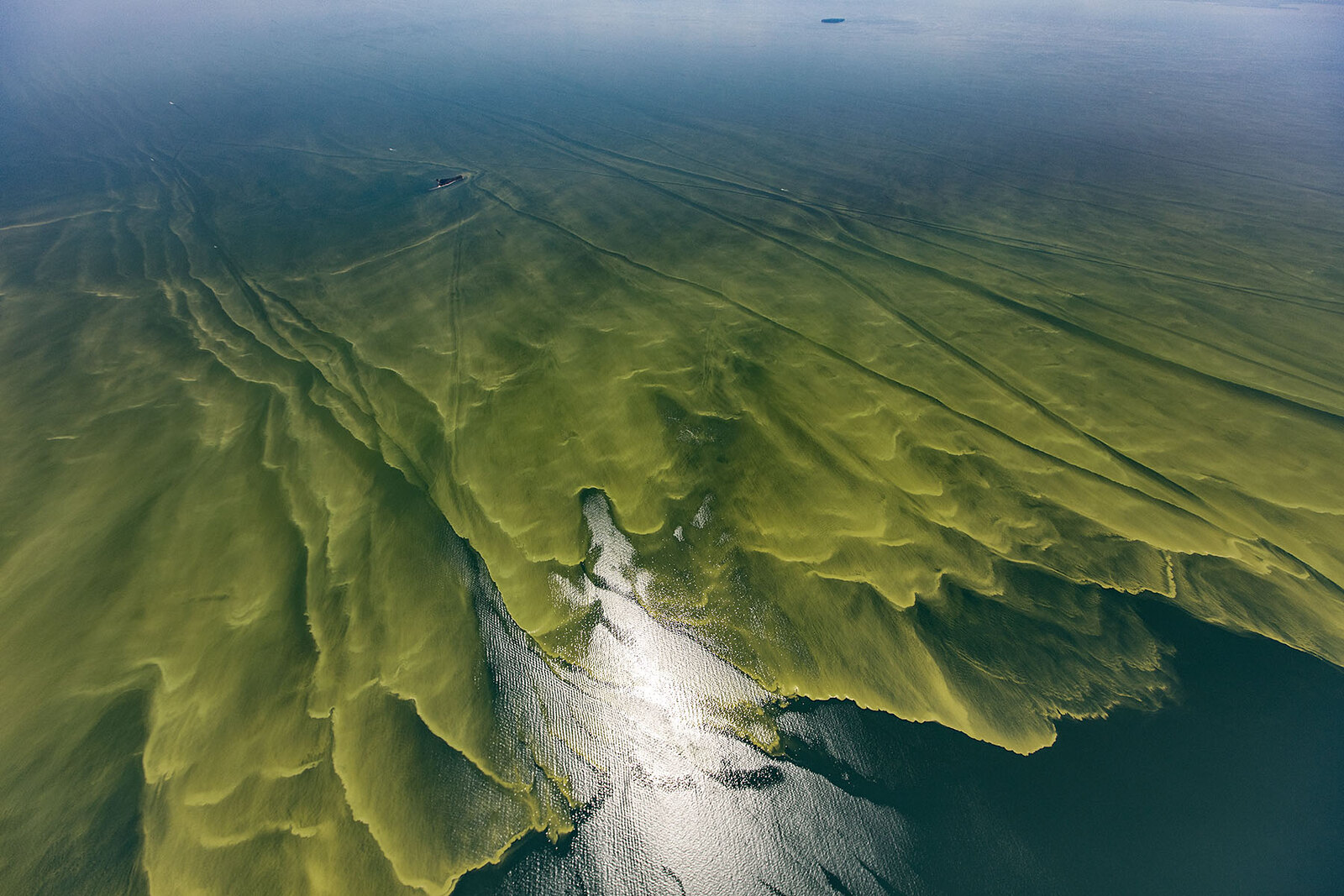
by DGR News Service | Dec 20, 2019 | Agriculture, Biodiversity & Habitat Destruction, Human Supremacy, Toxification
by Sean Butler and Will Falk / Featured image: an aerial photograph showing harmful algae blooms in Lake Erie in August of 2017. These are believed to be caused by the effluent runoff from factory farms in the watershed. Public domain photo by NOAA.
Rights of nature advocates often repeat the words, “The structure of the legal system makes meaningful environmental protection illegal.” It’s a bold claim, but for most people it’s too vague to mean anything. Most folks (understandably) don’t know the difference between a federal district court and a circuit court of appeals, let alone what we mean by the “structure” of the legal system.
But it’s actually quite simple. We’re referring to two aspects of the American legal system: (1) laws and regulations at the federal, state, and local (city and county) levels and the relative hierarchy among them; and (2) the holdings of various state and federal courts throughout the history of our country, which establish “precedent” for what those laws and regulations actually mean.
Perhaps nowhere in recent memory has the “structure of the legal system” been laid bare more clearly than in the aftermath of the passage of the Lake Erie Bill of Rights by the citizens of Toledo, OH in February 2019. The Lake Erie Bill of Rights (LEBOR) grants Lake Erie the rights to exist, flourish, and naturally evolve; grants the residents of Toledo a right to a healthy environment; and “elevates the rights of the community and its natural environment over powers claimed by certain corporations.”
Although remarkable on its face, LEBOR is only one of dozens of similar local laws that have been passed in recent years in cities and counties across the United States. What is truly remarkable is the response LEBOR has received from existing institutions.
Mere hours after the City of Toledo certified LEBOR’s election results, entrenched interests opposed to environmental protection leveraged the existing structure of American law to mount an urgent opposition to LEBOR. Drewes Farms Partnership (“Drewes Farms”), represented by a corporate law firm, sued the City seeking an injunction against enforcing the law on the basis that LEBOR violates Drewes Farms’ “civil rights.” The State of Ohio was allowed to intervene in the case to argue for LEBOR’s invalidation while the grassroots community group, Toledoans for Safe Water – who drafted LEBOR and ushered it through Ohio’s citizen initiative process — was barred from the case by the federal judge. Then, the Ohio State legislature (at the request of the Ohio Chamber of Commerce) included in its 2019 budget a provision explicitly making it illegal for local governments to make or enforce laws ascribing legal rights to nature.
In short, the existing legal system and those who profit from it brought the full weight of the legal system against LEBOR. To really understand what is meant when we say that the structure of the legal system makes meaningful environmental protection illegal we need to dig into the specifics of this onslaught.
LEBOR’s opponents make primarily two legal arguments against it. First, they claim that LEBOR should be invalidated because it infringes on corporate constitutional rights. Second, they argue that LEBOR is preempted by state and federal law that reserves the right of the state of Ohio and the federal government to legislate on environmental matters.
Drewes Farms makes the corporate constitutional rights argument very clearly in the complaint it filed in federal court, claiming that:
“LEBOR causes real and concrete harms on Drewes Farms by violating the United States Constitution including but not limited to:
- Depriving Drewes Farms of its fundamental right to freedom of speech and to petition the courts under the First Amendment;
- Violating Drewes Farms’ right to equal protection by targeting it for liability based solely on the fact that it operates as a partnership business entity;
- Violating the Fifth Amendment protection against vague laws by exposing Drewes Farms to strict criminal liability and massive damages and fines under a standardless Charter Amendment; and
- Depriving Drewes Farms of its rights without due process.”
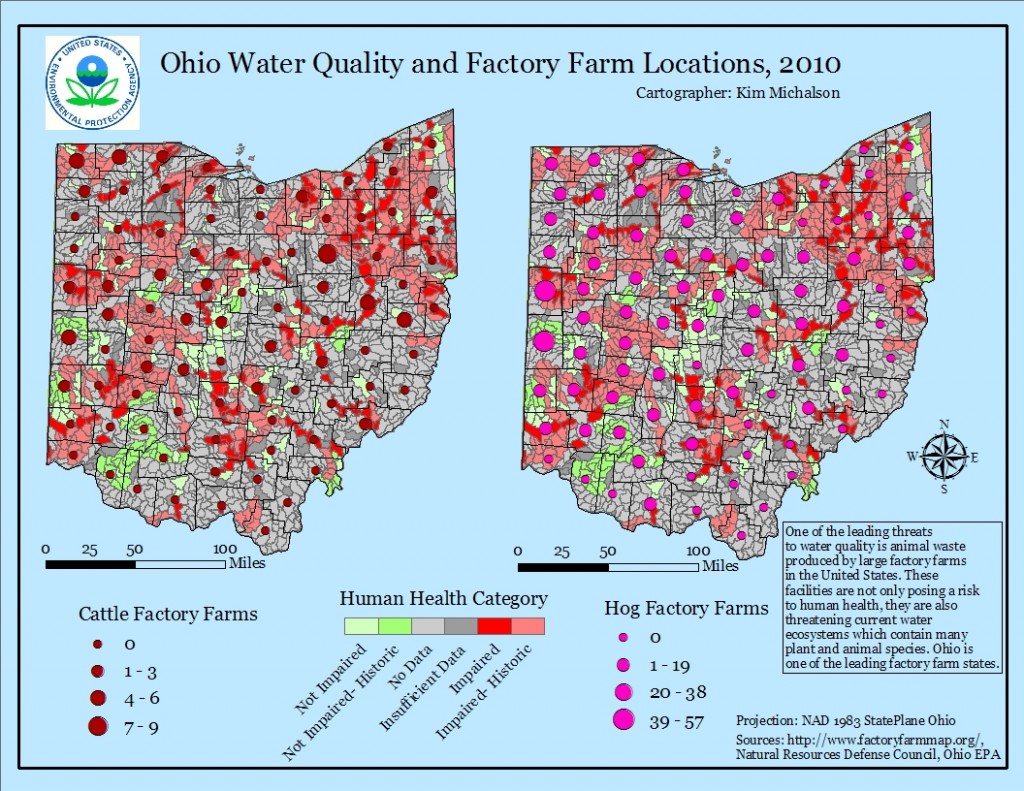
This 2010 map shows the location of major factory farming operations in Ohio and corresponding water quality readings. Ohio has among the highest density of CAFOs (Concentrated Animal Feeding Operations) of any U.S. state. Map by Kim Michalson.
Just so we’re clear, Drewes Farms, a non-human legal entity, lays claim to rights under the First, Fifth, and Fourteenth Amendments to the US Constitution AND claims that those rights are violated by a law that recognizes nature’s right to exist, flourish, and naturally evolve.
Meanwhile, the State of Ohio, in its Complaint for Declaratory Judgment and Injunctive Relief plainly states that “[t]he Ohio Constitution art. XVIII § 3 does not allow a municipality to enact an ordinance that prohibits regulated activity authorized under state permits issued pursuant to state laws of general applicability.” To support its claim, the State cited a recent Ohio case in which the judge ruled “[s]tate laws with state-wide application preempt local ordinances that discriminate, unfairly impede, or obstruct general laws regulating oil and gas activities.” In other words, the Ohio state constitution itself specifically prohibits any local government to enact laws that prohibit activities that are permitted by state laws.
The fundamental issue with both of these arguments is…they are absolutely, totally, and completely right. Under current American jurisprudence, Drewes Farms does have civil rights under the First, Fifth, and Fourteenth Amendments (among others), and LEBOR does violate principles of preemption.
And that is precisely the problem.
Because American law has long recognized corporate civil rights and has long used preemption to invalidate local laws that provide for stricter regulations than federal or state governments, the State of Ohio and Drewes Farms would have us believe that this should be the end of the discussion. But, ending the discussion here leaves several problematic assumptions unchallenged. Arguing that LEBOR should be invalidated because it infringes on corporate rights only makes sense if corporations should enjoy those rights under our system of law. And arguing that LEBOR should never be enforced because it violates established principles of preemption only makes sense if preemption is beneficial to American citizens.
So, we must dig deeper. We must ask: Why do corporations exist? What are corporate rights? Why does the American legal system afford corporations rights in the first place? We must also ask: Why does preemption exist? Why does the American legal system protect the state and federal governments’ power to preempt laws passed by local communities? And, is there a connection between growing corporate power and preemption?
While there is a debate about what corporations should exist to do, the fact remains that corporations exist to amass wealth, or to borrow one of corporate apologists’ favorite phrases, to “maximize shareholder value.” We can see this argument clearly in the hugely influential essay published in 1970 by the Nobel Prize-winning economist Milton Friedman in The New York Times Magazine aptly-titled “The Social Responsibility of Business is to Increase its Profits.” Environmental author and philosopher Derrick Jensen, in The Culture of Make Believe, is more direct:
“To expect corporations to function differently than they do is to engage in magical thinking. We may as well expect a clock to cook, a car to give birth, or a gun to plant flowers. The specific and explicit function of for-profit corporations is to amass wealth. The function is not to guarantee that children are raised in environments free of toxic chemicals, nor to respect the autonomy or existence of indigenous peoples, nor to protect the vocational or personal integrity of workers, nor to design safe modes of transportation, nor to support life on this planet. Nor is the function to serve communities. It never has been and never will be.”
Wealth is power. This is especially true in the legal system. Many people envision law as an all-powerful list of rules that dictates what someone can or cannot do. Similarly, many people think of rights as a list of privileges that specify what a person is entitled to do or entitled to be free from. As such, many people imagine that they can simply invoke these rights to be safe. But, it is a mistake to think that rules written somewhere in a book of statutes or rights listed in the Constitution have the power to jump off the paper where they are written and enforce themselves.
The key to understanding law and rights lies in understanding how they are enforced. Judges enforce law and rights by making decisions in court. And those decisions in court, in turn, are enforced by the police who are entitled to use physical force to ensure a judge’s decision is adhered to. When most people think about how this works, they envision examples such as President Eisenhower’s use of the National Guard to desegregate schools to uphold African Americans’ Fourteenth Amendment rights. But, a more apt and contemporary example is reflected in how the police were used at Standing Rock. Dogs, water cannons, and military-style weapons were turned against nonviolent protesters once the owner of the pipeline project, a corporation, won a favorable court ruling. These corporate rights-holders harnessed the state’s police power through the courts.

A typical “animal waste lagoon.” These containment ponds continuously leach into groundwater, and often overflow. Public domain photo by NRCS.
Rights, then, are power, too. When shareholders form a corporation, the corporation gains the privilege of “corporate personhood.” Because American courts treat corporations as “persons,” corporations have long exercised rights, including those afforded the highest level of protection under the Bill of Rights’ Contracts Clause, Due Process Clause, Fourteenth Amendment Equal Protection Clause, First Amendment, Fourth Amendment, Fifth Amendment Takings and Double Jeopardy Clauses, Sixth Amendment, and Seventh Amendment.
These rights have, for the most part, been judicially created and have consistently expanded throughout American history. The word “corporation” is found nowhere in the Constitution. Despite this, in 1819, in Dartmouth College v. Woodward, the U.S. Supreme Court ruled that the Contract Clause of the Constitution granted private business corporations protection from governmental interference in internal governance. In 1886, in Santa Clara County v. Southern Pacific Railroad Company, the Supreme Court ruled that a corporation is a person under the law and is therefore entitled to equal protection under the Fourteenth Amendment. In 1922, the Supreme Court ruled in Pennsylvania Coal Company v. Mahon, that coal corporations were entitled to protection under the Fifth Amendment “Takings Clause” and that the government must compensate corporations for property value lost due to mining regulations. In 2010, the Supreme Court ruled that federal laws which limited corporate spending in elections violated corporate First Amendment “free speech” rights in Citizens United v. Federal Elections Committee. Then, in 2014, the Supreme Court, in Burwell v. Hobby Lobby Stores, allowed corporations to deny its employees health coverage of contraception to which the employees would otherwise be entitled because corporations are entitled to First Amendment freedom of religion protection.
This might not seem problematic on its face, but recall that rights only have practical effect to the extent that rights holders can access the courts in order to ask a judge to enforce those rights. Corporations, that exist to, and have grown quite adept at, amassing wealth, have greater means to put behind the legal enforcement of rights. This naturally means more cases won by corporate plaintiffs, more caselaw upholding corporate rights, and therefore, by extension, more caselaw expanding the sphere of corporate civil rights. And the sheer number of cases bear out this reality. As an example, consider this: between 1868, when the Fourteenth Amendment was ratified, and 1912, the Supreme Court ruled on only 28 cases involving the rights of African Americans and an astonishing 312 cases on the rights of corporations, it is easy to conclude that the Fourteenth Amendment has done a better job protecting the rights of corporations than that of African Americans.
At the same time, the expansion of rights in one sphere necessarily produces the curtailing of rights in another. Deep ecologist John Livingston describes the problem:
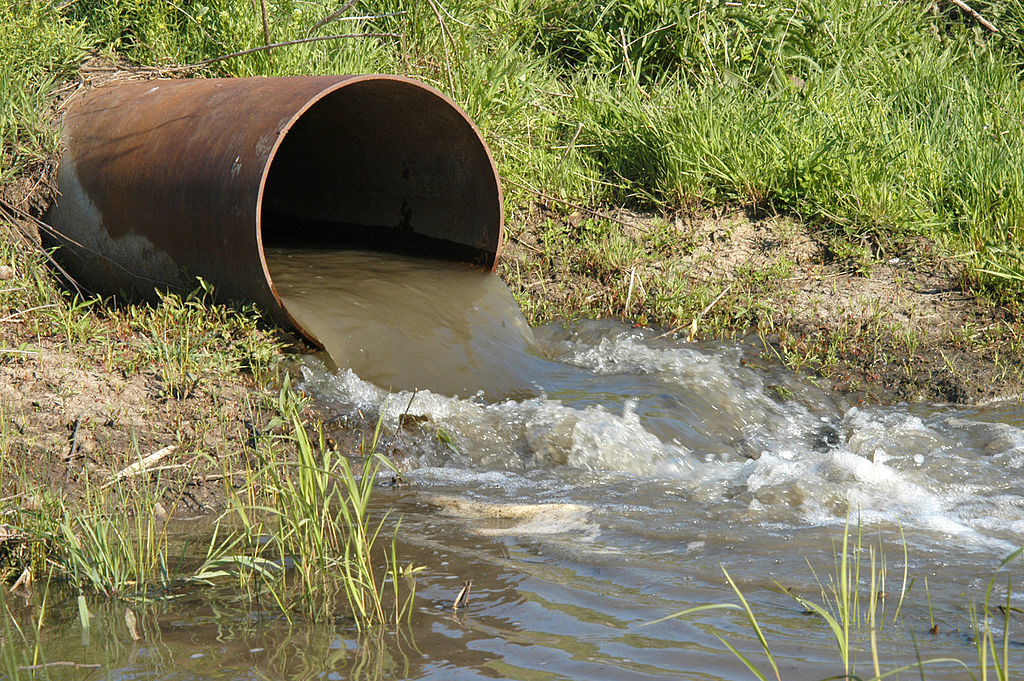
Effluent discharge pipe. Public domain image from USDA.
“We sometimes forget that every time a court or legislature – or even custom – confers or confirms a right in someone, someone else’s right is nibbled at: the right of women to equal employment opportunity is an infringement of the freedom of the misogynist employer; the right to make a profit is at someone else’s cost; the right to run a motorcycle or a snowmobile reduces someone else’s right to peace and quiet in his own backyard; the rights of embryos impinge upon the rights of the women who carry them. And so on.”
In other words, the expansion of corporate rights shrinks the rights enjoyed by citizens and communities. Because American law extends to corporations many of the same constitutional rights humans enjoy and because corporations exist to accumulate wealth, we should not be surprised when corporations use their power to do exactly that at the expense of the rights of human beings and nature.
The other major legal argument made against LEBOR is that it is preempted by state and federal law. Preemption is a doctrine that says the law of a higher jurisdiction should displace the law of a lower jurisdiction when the two jurisdictions conflict. The American legal system is divided basically into three jurisdictions: federal, state, and local law (local law is a general term for the law of the smallest legislating entities American law allows, entities such as municipalities, cities, or villages). When federal and state law conflict, American courts interpret the Supremacy Clause of the United States Constitution (Article VI, Section 2) to mean that federal law should displace state law. Similarly, state law usually trumps local law when the two conflict.
Corporations, using their superior wealth and their constitutional rights, have found tremendous success in influencing federal and state legislatures, especially pro-business, conservative legislatures and persuading them to enact aggressive new preemption laws. When local governments pass laws with stricter restrictions than the federal or state legislatures, corporations lobby legislatures to employ preemption to attack these local laws. This typically happens in one of two ways. First, government lawyers, primarily attorneys general, assert the doctrine of preemption in court. The State of Ohio’s arguments against LEBOR are a perfect example. Second, legislatures pass legislation known as “blanket” preemption to expressly forbid local ordinances that contradict state law. And, in fact, the Ohio House of Representatives recently employed blanket preemption when it adopted its 2020-2021 budget with provisions that prohibit anyone, including local governments, from enforcing rights of nature laws.
That’s what preemption is. The more important question is: Why does American law protect the federal and state governments’ power to preempt laws passed by local communities? The answer, quite simply, is corporate power.
The modern preemption doctrine was born from an 1868 decision written by Iowa Supreme Court Chief Justice John Dillon in The City of Clinton v. The Cedar Rapids and Missouri River Railroad Company. The case involved an attempt by the people of Clinton, Iowa to prevent railroad corporations from building railroads through their town. An ordinance was passed by the Clinton city council which prohibited any “railroad company from constructing its track through or upon any street within the limits of the city, and from occupying the same for right of way or other railroad purposes.”
In the decision, Dillon struck down Clinton’s ordinance and described his philosophy of the limited powers of municipal corporations and other local governing entities. This philosophy is now known as “Dillon’s Rule.” He wrote:
Municipal corporations owe their origin to, and derive their powers and rights wholly from, the legislature. It breathes into them the breath of life, without which they cannot exist. As it creates, so it may destroy. If it may destroy, it may abridge and control. Unless there is some constitutional limitation on the right, the legislature might, by a single act, if we can suppose it capable of so great a folly and so great a wrong, sweep from existence all of the municipal corporations in the State, and the corporation could not prevent it. We know of no limitation on this right so far as the corporations themselves are concerned. They are, so to phrase it, the mere tenants at will of the legislature. 24 Iowa 455, 475.

A pig at a factory farming operation. These industrial farms are the largest source of nutrient pollution in Lake Erie. https://creativecommons.org/licenses/by/2.0/ Via Mercy for Animals.
And, Dillon’s Rule was later adopted by the United States Supreme Court in 1907 in Hunter v. Pittsburgh.
As you can see, from the outset, preemption has been, quite literally, about corporations “railroading” local communities who do oppose destructive corporate projects. Today, preemption has grown into a powerful tool wielded by, especially, conservative, pro-business state legislatures. Judge Jon D. Russell and Aaron Bostrom, in a white paper titled “Federalism, Dillon Rule and Home Rule” recently written for the American City County Exchange (an organization that “helps to advance limited government and free market principles in local government through model policies, conferences, and online collaboration”), provide a solid example of the rationale employed by state legislators to defend preempting local laws.
Russell and Bostrom write:
The Dillon Rule guarantees a certain level of uniformity throughout the state…Rather than having vastly different policies and codes in each local jurisdiction, the state can create uniform tax codes and licensing policies, making it a business-friendly environment. Without commonality between local governments on these issues, businesses find more red tape than opportunity, making it difficult for the state and businesses to prosper.
Dr. Lori Riverstone-Newell, an expert in the interaction of governments in the American system, describes how in the past few years, “a growing number of state officials have sponsored and supported preemption legislation with the intent to weaken local authority and to thwart local progressive policies.” In simpler terms, conservative state legislators are learning how to use preemption to prevent progressive communities from enacting progressive laws.
We can see why some commentators argue we live in a corporate state. If the fundamental element of a democracy is the right of the people to enact and enforce the laws to which they are subject, then preemption is fundamentally an anti-democratic concept, especially as the doctrine has been influenced and wielded by entrenched economic interests and the state and federal legislators who support (and who are, of course, supported by) those interests.
Indeed legislators are not working alone; they are implementing policies pushed by corporate lobbyists. Dr. Riverstone-Newell explains, “Recent preemption efforts can be understood, at one level, as part of longstanding campaigns waged by industry groups hoping to stop or limit progressive local policies in order to create a friendlier business environment for themselves.” She describes how industry groups and trade associations first began pressuring state legislatures to rein in their cities in the late 1980s. R.J. Reynolds, the tobacco corporation, “pressed states to enact preemption laws in the 1980s as a central strategy to overcome local smoking restrictions and bans.” Abby Rapoport, a journalist writing for The American Prospect, reports how the National Rifle Association launched a campaign in the 1990s for state preemption of local gun regulations. This campaign was so successful “43 states now have some form of maximum preemption preventing localities from passing additional gun regulations on top of state law.”
It may very well be that “a certain level of uniformity” of laws in different jurisdictions enables business to “prosper,” but having reached the point in our nation’s history where we are confronting ecological collapse, we have to ask ourselves, whether blanket uniformity and unchecked economic growth and prosperity are the only values that matter to us. Or, instead, might it be that local environmental protection laws are key to protecting local ecology? Might it be that the unique ecosystems in one ‘jurisdiction’ require unique laws and regulations in order for them to thrive? Why should we expect that laws protecting swamplands in Florida be the same as those protecting the Nevada desert? If we are to see our way through the current environmental crisis, we can’t simply accept the doctrine of preemption on its face; we must consider the value of it, and its history and development, in order to determine whether or not it is compatible with the future we want for our grandchildren and the planet.
The failure to recognize how American law makes sustainability illegal is a primary reason environmentalists have failed to keep the health of the North American continent from deteriorating over the last century. Because we fail to recognize this, we keep seeking to protect the natural world through legal and political processes that do not – cannot – work. The late corporate anthropologist Jane Anne Morris described our predicament clairvoyantly:
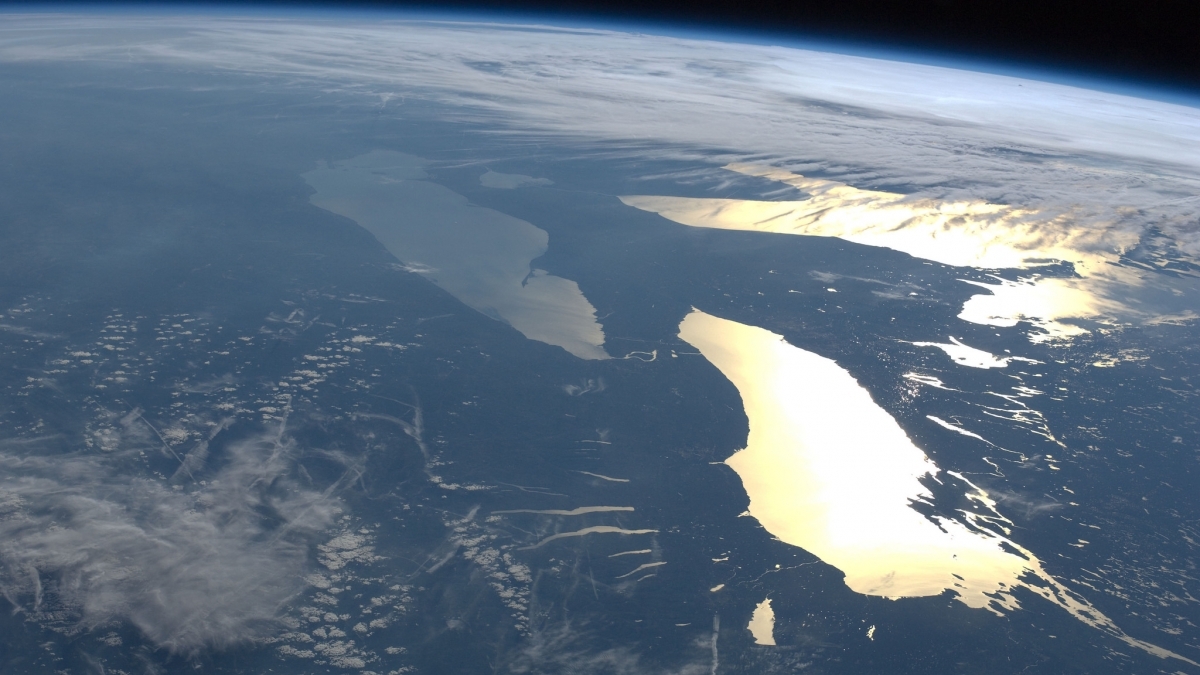
Lake Erie (left) is the 11th largest lake in the world. Public domain NASA photo.
“Our campaigns follow the gambling addiction model. The last bet didn’t pay off but the next one might if…if…if we just had a new, improved tripod, three more experts, more labor or church support, ten more elected officials on our side, a hundred more people at the demo, or a thousand more letters in the mail…Who are we kidding? We are just doing the ‘same old thing’ over and over again and fooling ourselves that it might work next time. We are stuck in a feedback loop where our failures are interpreted as signs that we should repeat our failed tactics, but try harder. This is what it is to be colonized.”
Lawyers, and their clients, are especially vulnerable to falling victim to Morris’ gambling addiction model. The adversarial, competitive nature of law where two or more sides jockey for the approval of a judge makes it easy for losing parties to conclude that if they just hired a more expensive law firm, or if they just argued an issue differently, or if they just cited this case instead of that case then they would have won. The problem, however, is not that we need to try harder; the problem is that the structure of American law prevents our ability to implement strong enough measures to truly protect the natural world.
The people of the City of Toledo, recognizing that corporate rights and preemption must be confronted and overturned to protect Lake Erie and all those who depend on her, voted to enact the Lake Erie Bill of Rights. The arguments made by the State of Ohio and Drewes Farms Partnership are currently the law en vogue. This is one of the major reasons American law makes sustainability illegal. This must change if the natural world, and all of us who depend on her, are going to survive the current ecological predicament. To achieve a sane, sustainable culture, corporate rights and preemption must go.
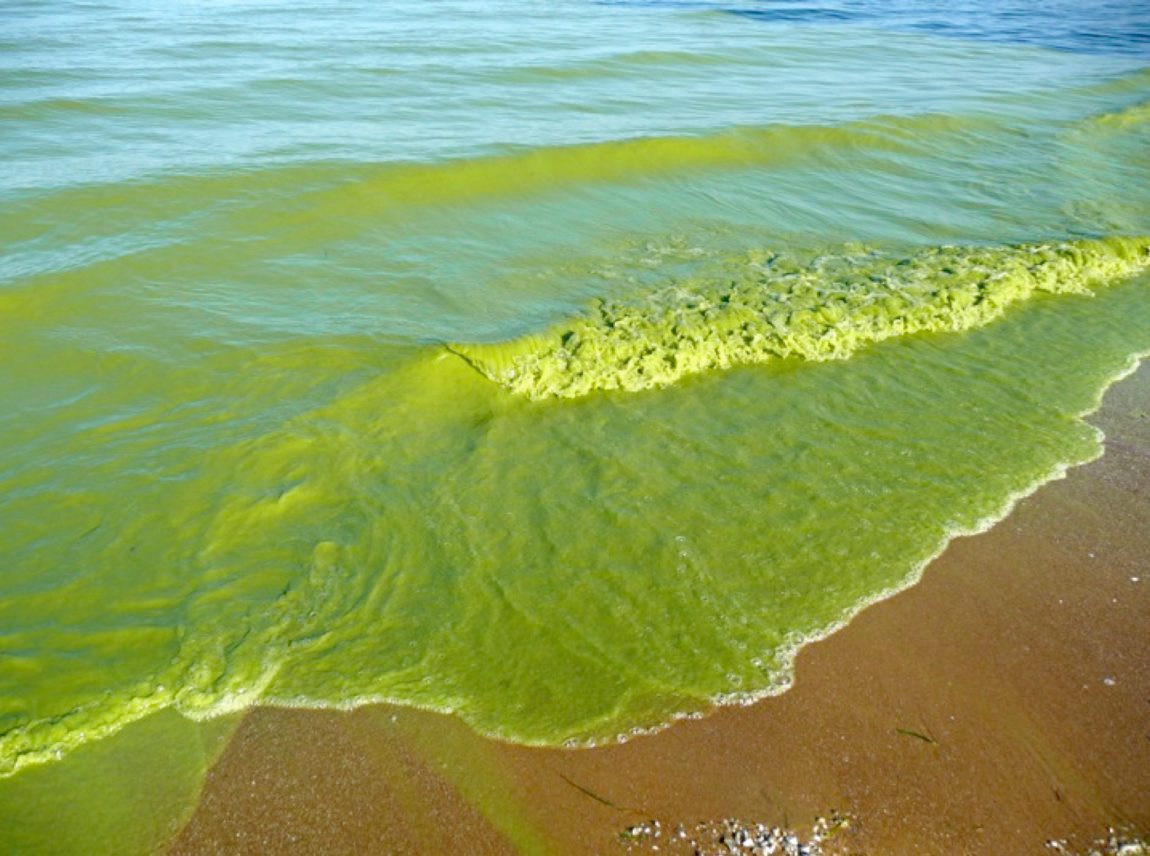
by DGR News Service | Jun 18, 2019 | Agriculture, Biodiversity & Habitat Destruction, The Solution: Resistance, Toxification
By Will Falk and Sean Butler
Photo: 2009 algae bloom in western Lake Erie. Photo by Tom Archer.
It should be clear to anyone following the events surrounding attempts by the citizens of Toledo, OH, with help from nonprofit law firm the Community Environmental Legal Defense Fund (CELDF), to protect Lake Erie with the Lake Erie Bill of Rights, that the American legal system and all levels of government in their current form exist to protect corporations’ ability to destroy nature in the name of profit and protect those corporations from outraged citizens injured by corporate activities.
In the scorching summer heat of August 2014, nearly half a million people in Toledo, OH were told not to use tap water for drinking, cooking, or bathing for three days because a harmful algae bloom poisoned Lake Erie. Harmful algae blooms on Lake Erie have become a regular phenomenon. They produce microcystin, a dangerous toxin. Microcystin “causes diarrhea, vomiting, and liver-functioning problems, and readily kills dogs and other small animals that drink contaminated water.” The Ohio Environmental Protection Agency reports that mere skin contact with microcystin-laden harmful algae blooms can cause “numbness, and dizziness, nausea…skin irritation or rashes.” Scientists have also discovered that harmful algae blooms produce a neurotoxin, BMAA, that causes neurodegenerative illness, and is associated with an increased risk of ALS, and possibly even Alzheimer’s and Parkinson’s. In 2018, a federal judge found that the principal causes of Lake Erie’s perennial harmful algae blooms are “phosphorus runoff from fertilizer, farmland manure, and, to a lesser extent, industrial sources and sewage treatment plant discharges.”
The Environmental Working Group and Environmental Law and Policy Center report that, not surprisingly, between 2005 and 2018 the number of factory farms in the Maumee river watershed – a river that flows into Lake Erie and boasts the largest drainage area of any Great Lakes river
“exploded from 545 to 775, a 42 percent increase. The number of animals in the watershed more than doubled, from 9 million to 20.4 million. The amount of manure produced and applied to farmland in the watershed swelled from 3.9 million tons each year to 5.5 million tons.”
The groups also state that “[t]he amount of phosphorus added to the watershed from manure increased by a staggering 67 percent between 2005 and 2018.” And, “69 percent of all the phosphorus added to the watershed each year comes from factory farms in Ohio.”
Many Americans believe regulatory laws like the Clean Water Act and regulatory agencies like the United States Environmental Protection Agency (EPA) exist to protect against phenomena like harmful algae blooms. But, Senior US District Court Judge James G. Carr recently described how regulatory laws and agencies have failed to protect Lake Erie. In a 2018 decision in a case brought by the Environmental Law and Policy Center under the Clean Water Act for the failures of the US and Ohio EPAs, Carr described, “Ohio’s long-standing, persistent reluctance and, on occasion, refusal, to comply with the [Clean Water Act].” He also wrote:
“As a result of the State’s inattention to the need, too long manifest, to take effective steps to ensure that Lake Erie (the Lake) will dependably provide clean, healthful water, the risk remains that sometime in the future, upwards of 500,000 Northwest Ohio residents will again, as they did in August 2014, be deprived of clean, safe water for drinking, bathing, and other normal and necessary uses.”
Despite Carr explaining that he “appreciate[s] plaintiffs’ frustration with Ohio’s possible continuation of its inaction,” he ruled that he could not expedite Ohio’s compliance with the Clean Water Act because he could not determine that Ohio had “clearly and unambiguously” abandoned its obligations under the Clean Water Act.
In response to the regulatory framework’s failure to stop harmful algae blooms, on Tuesday, February 26, 2019, citizens in Toledo, OH voted to protect Lake Erie with the Lake Erie Bill of Rights (“LEBOR” or “the Bill”). The Bill “establishes irrevocable rights for the Lake Erie Ecosystem to exist, flourish, and naturally evolve, a right to a healthy environment for the residents of Toledo” and “elevates the rights of the community and its natural environment over powers claimed by certain corporations.”
Toledoans for Safe Water (TSW) is the grassroots coalition of local Toledo citizens who ushered the Bill through Ohio’s constitutional citizen initiative process. Ohio’s citizen initiative process allows citizens to draft and propose laws and to place those laws on a ballot so citizens can directly vote on the law’s enactment. Typically, laws are drafted, proposed, and voted on solely by legislators. Initiative processes like Ohio’s are some of the only avenues American citizens have for directly proposing and enacting laws and providing a direct check and balance on an “out of touch” or corrupt legislature. It is important to understand, however, that, even with citizen initiative processes, it is incredibly difficult to not only democratically enact laws that would actually protect the natural world, but it is incredibly difficult to even place rights of nature laws on the ballot in the first place.
Toledoans for Safe Water’s experience is enlightening. Formed after the harmful algae bloom of August 2014, TSW worked tirelessly to pass an initiative protecting their water source including overcoming efforts by the Lucas County Board of Elections and BP North America to keep such an initiative off the ballot. First, TSW had to gather 5,244 signatures to place LEBOR on the ballot. They far exceeded that total by gathering approximately 10,500 signatures. Despite gathering much more than the necessary signatures, the Lucas County Board of Elections voted against putting the initiative on the November 2018 ballot.
Toledoans for Safe Water members sought an order from the Ohio Supreme Court to put the measure on the ballot, but the Court denied the request in September 2018. Fortunately, in October 2018, in another case involving a different charter initiative, the Ohio Supreme Court ruled that city councils may force county boards of election to place charter amendment initiatives on the ballot. This ruling expressly overruled precedent previously relied on to prevent Toledo citizens from voting on LEBOR. Armed with this new ruling, TSW successfully asked the Toledo City Council to put LEBOR on the ballot. However, in December 2018, a Toledo citizen sought a writ of prohibition from the Ohio Supreme Court to block LEBOR. TSW found themselves in front of the Ohio Supreme Court once again. This time TSW won.
After ensuring LEBOR made it to the ballot, Toledoans for Safe Water had to convince enough voters to vote for the Bill before it could be enacted. In the weeks leading up to the election, BP North America wired $302,000 to the Toledo Coalition for Jobs and Growth, the primary group opposing LEBOR. In the end, TSW spent $7,762 in support of LEBOR, while Toledo Coalition for Jobs and Growth, with the massive donation from BP North America, spent $313, 205 to stop LEBOR. Despite this disparity, LEBOR passed with 61 percent of the 15,000 Toledoans who voted.
But, mere hours after the City of Toledo certified LEBOR’s election results, Drewes Farms Partnership sued the City seeking an injunction against enforcing LEBOR and a court ruling that LEBOR is unconstitutional. Several Toledo city-council members spoke out against the enactment of LEBOR before the election, and it appears that the City will not enforce LEBOR. Yes, you read that correctly: After LEBOR won with 61% of the vote (nearly two-thirds of those who voted), the City of Toledo agreed to an injunction prohibiting them from enforcing the law.
In response to such bald face tactics, we must ask, if a local city government agrees not to enforce the will of its citizens, then what really is left of the notion of a government for and by the people? And the inevitable answer must be, nothing. Indeed, as environmental author Derrick Jensen explains in his book Endgame:
“Surely by now there can be few here who still believe the purpose of government is to protect us from the destructive activities of corporations. At last most of us must understand that the opposite is true: that the primary purpose of government is to protect those who run the economy from the outrage of injured citizens.”
Jensen’s conclusion eerily reflects the very plain statement by Attorney General Richard Olney, who served under President Grover Cleveland in 1894 about the newly-formed Interstate Commerce Commission. The ICC was the very first federal regulatory agency, created to ‘regulate’ the railroad industry, but as Olney (a former railroad attorney, himself) said:
“The Commission…is, or can be, made of great use to the railroads. It satisfies the popular clamor for a government supervision of railroads, at the same time that that supervision is almost entirely nominal. Further, the older such a commission gets to be, the more inclined it will be found to take the business and railroad view of things.”
Nearly 200 years later, Jensen’s observation reflects the reality that not only does our regulatory system not protect the interests of the people of this country; it was never intended to. It was created to protect industry.
And so the parade of horribles that Toledoans for Safe Water have encountered should come as no surprise. A little over two months after the lawsuit was filed by the agriculture industry to strike down LEBOR, the State of Ohio requested, and was granted, the right to intervene to argue with Drewes Farms Partnership that LEBOR should be invalidated. TSW also tried to intervene on behalf of Lake Erie, exercising their new rights under LEBOR and arguing that the City is not an adequate representative of LEBOR. The City neither opposed TSW’s intervention in the case, nor denied that it would be an inadequate representative of LEBOR. Regardless, on Tuesday, May 7, Judge Jack Zouhary, a U.S. District Judge in the Northern District of Ohio, Western Division denied Toledoans for Safe Water’s intervention. Lake Erie and TSW asked the Sixth Circuit Court of Appeals to stay (legalese for postpone) the case while they appealed Zouhary’s denial of their intervention. But, the Sixth Circuit refused to stay the case.
Because Zouhary has denied Toledoans for Safe Water’s intervention and the Sixth Circuit did not grant Lake Erie’s and TSW’s request to stay the case, it will proceed with no one who supports LEBOR present to argue on behalf of Lake Erie or the citizens of Toledo for the remainder of a case that will decide the fate of a law enacted by the citizens of Toledo. To be clear, the City government, popularly assumed to represent the will of the City’s people, is specifically not representing the will of the people.
About an hour after denying Lake Erie and Toledoans for Safe Water’s intervention, Zouhary scheduled a phone conference for Friday, May 17 while ordering the parties to the lawsuit to send him letters regarding a Motion for Judgment on the Pleadings. Typically, parties to a lawsuit file motions and briefs describing their arguments and these motions and briefs become part of the public record so that the public can see why legal decisions are made. In specifically asking for letters, Zouhary shielded Drewes Farms Partnership’s, the State of Ohio’s, and the City of Toledo’s arguments from public scrutiny. Here we see how the will of the people, expressed through the legislative process, can be effectively silenced by the judicial process. The courts, commonly thought of as a check on abuses of power by the legislative branch of government that encroach on fundamental rights of individuals, have now been unmasked as a vehicle to silence and overturn the will of the people and to legitimize further violations of fundamental rights of the people – in this case the simple and essential right to clean water.
And to round out the evidence that we do not live in a democracy, on Thursday, May 9, the Ohio House of Representatives adopted its 2020-2021 budget with provisions that prohibit anyone, including local governments, from enforcing rights of nature laws. The State of Ohio is using its power of preemption – a long-established legal doctrine that defines the relationship of municipal governments to state and federal governments as one of parent to a child – to prevent Ohio residents from protecting the natural world with rights of nature at any time in the future.
This is a perfect example of why CELDF lawyer and executive director Thomas Linzey often states that, “Sustainability itself has been rendered illegal under our system of law.” And:
“Under our system of law, you see, it doesn’t matter how many people mobilize or who we elect – simply because the levers of law can’t be directly exercised by them. And even when they do manage to swing the smallest of those levers, they get swung back (either through the legislature or the courts) by a corporate minority who claimed control over them a long time ago.”
Toledoans for Safe Water swung “the smallest of those levers” and now they have been “swung back” by both the legislature and the courts in favor of the corporate minority. We see then, that under our current system of laws, there is no government actor that validates and protects the will of the people. In the case of Lake Erie, the City of Toledo, the State of Ohio, two levels of federal courts (the District Court for the District of Ohio and the Sixth Circuit Court of Appeals), have all actively undermined the health and welfare and the express political will of the citizens of Toledo – all in the name of preserving and protecting the freedom of agricultural interests to continue polluting Lake Erie for the sake of their own profits.
***
With it being all but certain that the Lake Erie Bill of Rights will soon be officially invalidated, has Toledoans for Safe Water’s work been in vain?
Not entirely.
“Unquestioned beliefs are the real authorities of a culture,” critic Robert Coombs tells us. Right now, the culture of profit in our country, sanctioned by the legal system is destroying the planet. Informing this dominant culture is a collection of unquestioned beliefs that authorize and allow the massive environmental destruction we currently witness. Stopping the destruction requires changing the dominant culture and changing the dominant culture requires publicly challenging unquestioned beliefs so those unquestioned beliefs are exposed to the light where they can be seen, understood, and condemned.
Perhaps surprisingly, one of the unquestioned beliefs authorizing ecocide is the belief that we live in a democracy and, because we live in a democracy, that our government reflects the will of the governed. This mistaken belief leads to more mistaken beliefs including a belief that the best way to make change is to petition your elected representatives, and if they won’t listen, to elect new ones who will. This misconception includes the further mistaken belief that the American regulatory framework exists to protect the natural world and the humans who depend on Her and that therefore filing lawsuits under the Endangered Species Act, the National Environmental Policy Act, and the Clean Air and Clean Water Acts can stop the destruction of endangered species, our habitat, and the air and water we require.
We should all know the truth, by now. We do not live in a democracy, and our government was never intended to reflect the will of the governed. Our elected representatives only listen to us when the corporations they’re beholden to aren’t telling them what to do. The regulatory framework does not exist primarily to protect the natural world; it exists to issue permits, to give permission, to legalize the harm corporate projects wreak on the natural world, and to make it near impossible for the citizenry to oppose those projects.
Even some of the current government’s most sacred documents, such as the Declaration of Independence, the Ohio State Constitution, as well as many other state constitutions, declare that people have a right to reform, alter, or even abolish the very governments those documents create when those governments fail to reflect the will of the people. The people of Toledo tried to exercise that right by passing LEBOR. Regardless, the very institutions supposedly tasked with honoring these documents are preventing the people from exercising the rights asserted in the Declaration of Independence and protected by the Ohio State Constitution.
We should all know the truth, by now, but most people still don’t. It’s one thing to tell people the truth. And, it’s another to show them. A major question, then, for social and environmental justice advocates is: How do we show people the truth?
One way is through acts of civil disobedience like enacting the Lake Erie Bill of Rights. A primary purpose of civil disobedience is to expose unquestioned beliefs for what they really are. In the case of the regulatory fallacy described above, these unquestioned beliefs serve as propaganda intended to pacify the people. Civil disobedience can stage the truth of our situation for the public to behold. Properly applied, civil disobedience can illuminate unquestioned beliefs and unveil their falsehoods.
CELDF attacks unquestioned beliefs through what it calls “organizing jujitsu.” CELDF helps communities suffering from destructive corporate projects (like fracking, factory farms, and toxic waste storage) ban those projects by passing local laws establishing rights of nature and invalidating judicially-created corporate rights. These laws, however, are currently illegal under American law and are, inevitably, struck down by the courts.
So, why does CELDF keep helping communities pass laws that are almost always struck down? This is where the organizing jujitsu happens. The laws that CELDF helps communities pass are frontal challenges to long-settled legal doctrines. When judges rule against local laws, judges’ rulings can be used as proof of how the structure actually operates. In CELDF’s words:
“Much like using single matches to illuminate a painting in a dark room, enough matches need to be struck simultaneously (and burn long enough) so that the painting can be viewed in its entirety. Each municipality is a match, and each instance of a law being overturned as violative of these legal doctrines is an opportunity for people to see how the structure actually functions. This does the necessary work of penetrating the denial, piercing the illusion of democracy, and removing the blinders that prevent a large majority of people from seeing the reality on the ground.”
With the indicators of ecological collapse constantly intensifying, it is imperative that we penetrate the denial, pierce the illusion of democracy, and remove the blinders that prevent people from seeing reality as quickly as possible. Due to the thoroughness of American indoctrination, the education civil disobedience can provide needs to be supported by real-time commentary that highlights why a specific tactic failed. This real-time commentary will help the public see the truth.
Toledoans for Safe Water has used every legal means at their disposal to protect Lake Erie and, yet, the Lake Erie Bill of Rights is not being enforced and is almost certain to be invalidated in court. Meanwhile, the poisoning of Lake Erie intensifies. Toledoans for Safe Water’s civil disobedience, despite challenging a widespread faith in the American legal system, has failed to physically protect Lake Erie. Breaking this faith is a necessary, but not sufficient, step towards dismantling the dominant culture and replacing it with a new culture rooted in a humble recognition of our dependency on the natural world. For those who see the truth that neither the legal system nor the government will protect us, the question becomes: What are we willing to do to protect ourselves?
—
Will Falk is a biophilic writer and lawyer. He believes the natural world speaks. And, his work is an attempt to listen. In 2017, he helped to file the first-ever federal lawsuit seeking rights of nature for a major ecosystem, the Colorado River. His book How Dams Fall which chronicles his experiences representing the Colorado River in the lawsuit, will be published by HomeBound Publications in October, 2019. You can follow Will’s work at willfalk.org.
Sean Butler is a technology lawyer and environmental activist based in Sequim, WA. In addition to his practice supporting venture-backed startups he is working to advance the rights of nature.
by DGR News Service | May 8, 2019 | Movement Building & Support, The Solution: Resistance
Resistance News
May 8, 2019
by Max Wilbert
Deep Green Resistance
max@maxwilbert.org
https://www.deepgreenresistance.org
Current atmospheric CO2 level (daily high from May 6th at Mauna Loa): 414.49 PPM
A free monthly newsletter providing analysis and commentary on ecology, global capitalism, empire, and revolution. For back issues, to read this issue online, or to subscribe via email or RSS, visit the Resistance News web page. Most of these essays also appear on the DGR News Service, which also includes an active comment section.
** *** ***** ******* *********** *************
In this issue:
- New DGR Podcast: The Green Flame
- A Modern Eco-Sabotage Manifesto
- The Legal System Will Not Save the Planet
- The problem with putting a price on nature
- Fighting for the Rights of Southern Resident Orcas
- All Oppression is Connected
- Submit your material to the Deep Green Resistance News Service
- Further news and recommended reading / podcasts
- How to support DGR or get involved
** *** ***** ******* *********** *************
Revolution is never practical – until the hour of the revolution strikes. THEN it alone is practical, and all the efforts of the conservatives, and compromisers become the most futile and visionary of human imaginings.
— James Connolly, “Socialism Made Easy” (1909)
** *** ***** ******* *********** *************
New DGR Podcast: The Green Flame
We are proud to announce a new project: The Green Flame, a Deep Green Resistance podcast offering revolutionary analysis, skill sharing, and inspiration for the movement to save the planet by any means necessary. Our hosts are Max Wilbert and Jennifer Murnan.
First episode: https://www.youtube.com/watch?v=FmZHyll9FtQ
Our first episode features Elisabeth Robson on why she calls The Green New Deal a “moral hazard,” a beautiful interview with the incomparable Saba Malik, who shares stories of gifting and receiving, of embracing and defending communities that are worth fighting for, and a poem by Michelle Lynn Jones that will leave you feeling as integrally a part of this living planet as you actually are.
You can subscribe on iTunes, Stitcher, Google Play, or anywhere else you get your podcasts. More episodes coming soon.
iTunes: https://podcasts.apple.com/us/podcast/the-green-flame/id1460594346
Stitcher: https://www.stitcher.com/podcast/max-wilbert/the-green-flame
YouTube: https://www.youtube.com/user/DeepGreenResistance/videos
RSS: https://greenflame.libsyn.com/rss
** *** ***** ******* *********** *************
A Modern Eco-Sabotage Manifesto
[Link] By Max Wilbert
The woman places an arrow on her bow, draws to her cheek, and fires.
The arrow arcs over a high-voltage electrical transmission line, carrying a non-conductive rope. She jogs to her arrow, and begins to reel in the rope. As she pulls it over the lines, a conductive cable is revealed to be attached to its end. As the cable bridges the three-phase power lines, a short-circuit ripples down the lines. Miles away, an aluminum smelter grinds to a halt.
This is the opening of the new film Woman at War from director Benedikt Erlingsson. The film follows a one-woman ecosabotage campaign against the Icelandic aluminum industry.
Whenever I watch a film, especially a film grappling with the ecological crisis, I expect it to disappoint me. Ethan Hawke’s First Reformed, for example, started with a promising premise and then veered into self-flagellation and misogyny.
Woman at War, however, did not disappoint. Halldóra Geirharðsdóttir gives a masterful performance as Halla, a happy middle-aged woman who appears content with her life as a choir director in an Icelandic city. She moves about her life with grace and serenity, riding her bicycle through the streets, swimming in the ocean, and talking with her sister and other friends.
But Halla leads a double life. Her apparently tranquil existence hides her true mission, a campaign against heavy industry that is destroying Iceland. A portrait of Nelson Mandela hangs on her wall at home, a constant reminder that yesterday’s terrorists may become the freedom fighters of history. This is, no doubt, a reference to the ANC sabotage campaigns that Mandela helped to lead in Apartheid South Africa beginning in 1961.
In his testimony when he was sentenced, Mandela describes his reasoning: “I do not deny that I planned sabotage,” he said. “I did not plan it in a spirit of recklessness nor because I have any love of violence. I planned it as a result of a calm and sober assessment of the political situation that had arisen after many years of tyranny, exploitation and oppression of my people by the whites.”
The same reasoning is true for eco-saboteurs today. In the era of climate chaos and government inaction, “extreme” acts like ecosabotage are not extreme at all. They are, in fact, some of the most reasonable responses imaginable.
The argument for sabotage in Woman at War is as undeniably real as the industry it tackles. Iceland’s abundant geothermal energy and hydropower extraction give it very low electricity prices, and has made it a global hot spot for aluminum smelting. The three aluminum smelters in Iceland use a full 73 percent of all electricity generated in the country.
Their power is supplied by geothermal energy harvesting facilities as well as a highly controversial hydroelectric dam that was opposed by environmental and community groups in the courts, via protest, and with direct action and ecosabotage. The smelters themselves are major polluters linked to birth defects, cancer, and bone deformations in nearby communities.
In the film, Halla’s attacks are not spontaneous. Like Mandela, she has obviously conducted a rigorous assessment of the situation. Her actions are meticulously planned. She receives intelligence from a friend high in the Icelandic government. She operates carefully, intelligently, implementing reasonable security precautions while avoiding wholesale paranoia.
At one point, Halla evades her face being recorded by a drone by wearing a Nelson Mandela mask, in an echo of Mandela’s words in his book Long Walk to Freedom: “Living underground requires a seismic psychological shift,” Mandela wrote. “One has to plan every action, however small and seemingly insignificant. Nothing is innocent. Everything is questioned. You cannot be yourself; you must fully inhabit whatever role you have assumed… The key to being underground is to be invisible.”
Like any effective underground figure, she follows the maxim that “Clandestine operational activity must be compartment[aliz]ed, it must be planned, it must be short in duration, and it must be rehearsed (or at least, composed of habitual actions).”
Rebecca Solnit, who has written some wonderful things, critiques Woman at War, writing that “our largest problems won’t be solved by heroes.” But Solnit then lauds Bill McKibben, founder of 350.org, an organization which (like the entire American environmental movement) has failed to stop even the growth of fossil fuel burning. McKibben’s entire approach hinges on a transition to green technology that, as I explain in my forthcoming book Bright Green Lies, has thus far failed to reduce emissions even by a fraction.
In contrast, eco-sabotage groups like MEND (the Movement for the Emancipation of the Niger Delta) have reduced oil output in Nigeria, Africa’s largest producer, by up to 40 percent on a sustained basis.
So which approach is really effective? Show me a country in which mass action has significantly reduced carbon emissions, and perhaps Solnit’s argument would hold more weight. Just two people conducting eco-sabotage against the Dakota Access Pipeline (DAPL) were nearly as effective in slowing the construction as tens of thousands were at Standing Rock. Imagine if a few more people had joined them. And a few more. And more.
As director Benedikt Erlingsson said of Halla in a recent interview, “She’s not a terrorist, she’s not creating terror, she’s not harming people. She’s only sabotaging structures. But she is doing what all fighters have been doing: for non-violent protest to work, it always needs to have an economic fist.”
Petitioning those in power to change things simply isn’t working. To have a chance of planetary survival, we need the most direct of direct actions.
Practically, there are a few lessons to be learned from Woman at War. For example, the film showcases perhaps the high end of effectiveness for a single saboteur. By acting in coordinated groups or securely linked cells, a larger number of people could be more effective. Additionally, the film shows the importance of building a culture of resistance. Halla is saved early on by a nearby farmer who detests the transmission lines and police crisscrossing the land his family has lived on for a thousand years. This element shows the importance of building a support network that can house, feed, transport, and otherwise support underground resistance—and won’t ask too many questions.
There is much to love about this film. Aesthetically, it is beautifully done. The music is superb. The Icelandic tundra, glaciers, rivers, hot springs, and stones are a presence all their own, and Halla inhabits this landscape throughout, repeatedly pressing her face into the thick moss as if into the embrace of a dear friend. She also demonstrates quite clearly that, in an asymmetric struggle, bushcrafts, physical fitness, and wilderness travel skills are a serious advantage for clandestine eco-resistance.
Woman at War bypasses American sexualization, casting a strong female lead acting on her own terms, without a hint of objectification. It even tackles prison well, showing that (to quote Mandela once again) “The challenge for every prisoner, particularly every political prisoner, is how to survive prison intact, how to emerge from prison undiminished, how to conserve and even replenish one’s beliefs.”
Ending a movie like this is hard. In reality, revolutionary work is likely to end with prison time, death, or international exile. But Woman at War closes deftly, in the same way it tackles tricky topics like morality, jobs, and family. Halla visits Ukraine to adopt a young girl, and on her return to the airport, is forced to carry her through a slowly-rising flood that has blocked the road. It is tranquil but daunting slow-moving emergency submerging the entire world. A fitting metaphor, then, for the theme of the entire film.
As I finish writing this review, spring is in full bloom. The birds are singing outside my small cabin in the Oregon woods. But I know that the slow-moving floods of climate change, species extinction, toxification, overpopulation, habitat destruction, and refugees are rising. Year by year, we are slipping into a nightmare. Woman at War is not exactly a template, but it is a great beginning point for a movement that could save us from the worst of what is coming, if only we are ready to listen.
** *** ***** ******* *********** *************
The Legal System Will Not Save the Planet
[Link]
DGR member and lawyer Will Falk explains why the legal and regulatory system is structurally incapable of defending the natural world from threats, because it was never designed to do this. His conclusion is that communities must organize around revolutionary, ecological principles to defend the land themselves. We cannot rely on government to do it for us.
Video here: https://dgrnewsservice.org/resistance/indirect/lobbying/the-legal-system-will-not-save-the-planet/
** *** ***** ******* *********** *************
The problem with putting a price on nature
[Link] By Beth Robson / Art for Culture Change
I love the cover of the New York Times Magazine, by Pablo Delcan, for this week’s big story, “The Problem with Putting a Price on the End of the World.”
The article discusses the challenge with pricing carbon emissions properly so that we use less fossil fuels: because fossil fuels are so fundamental to every aspect of how we live in this modern culture, to price emissions higher means bringing a world of hurt to people who just want to be able to afford a home, or to commute to work, or put the next meal on the table.
The basic problem with pricing carbon as a solution to climate change is not, as the article states (and most people like to claim), that it is a “market failure”.
The problem is that pricing carbon doesn’t address the underlying issue: that our modern culture is inherently unsustainable, no matter how much we pay for the energy to run it.
The article argues that pricing carbon leads to a sluggish economy, which is bad.
No, what’s bad is the economy, period. Our modern economy is based on continual growth. We can’t “fix” the economy; we have to abolish it. Eliminate it. And to do that we need a vision of what is to replace it (and no, not “clean energy”!!) — because without a vision, people just get angry when they can no longer afford the necessities of life.
Unfortunately but unsurprisingly, this article pins hopes for the future on “clean” energy (something that doesn’t actually exist), and a growth economy based on renewables, within the framing of shifting away from fossil fuels not because carbon is expensive, but because renewables are a better, cheaper option, cause less pollution and less carbon, and will create jobs (i.e., basically the same argument as The Green New Deal). This approach simply changes the energy source that runs our unsustainable economy; it doesn’t change the underlying problem: the economy and the way we live our lives because of that economy.
Read on.
** *** ***** ******* *********** *************
Fighting for the Rights of Southern Resident Orcas
[Link] By Will Falk and Sean Butler / Voices for Biodiversity
On December 18, 2018, the Center for Biological Diversity and the Wild Fish Conservancy threatened the Trump administration with a lawsuit under the Endangered Species Act (ESA) for allowing salmon fisheries to take too many salmon, which the critically endangered Southern Resident orcas depend on for food.
The impulse to protect the orcas is a good one. Southern Resident orcas are struggling to survive — only 75 remain. According to the statement by the Center for Biological Diversity and Wild Fish Conservancy, “The primary threats to Southern Resident killer whales are starvation from lack of adequate prey (predominantly Chinook salmon), vessel noise …that interferes with … foraging … and toxic contaminants that bioaccumulate in the orcas’ fat.”
You probably assume, when reading that list of primary threats to the orcas, that the threatened lawsuit would demand an end to these harmful activities. But it doesn’t. Instead, the organizations are merely asking the National Marine Fisheries Service — the agency responsible for issuing permits to Pacific coast fisheries — to deal with alleged violations of the ESA.
The Center for Biological Diversity and the Wild Fish Conservancy aren’t asking that activities harmful to Chinook salmon, and consequently to the Southern Resident orcas, be stopped. They aren’t asking for noisy vessels that disturb the whales’ foraging behaviors to be prohibited. They aren’t even asking for an end to the toxic contaminants that accumulate in the whales’ fat.
Why aren’t they asking for any of these things? Because under American law they aren’t allowed to ask for them.
All they are asking is that these harmful activities receive the proper permits.
Right now, laws like the Endangered Species Act are the main legal means for protecting threatened species and habitat in the United States. But these laws only allow us to challenge permit applications and ask that projects complete the permit process.
While it may hard to believe, these permits are designed to give permission to cause harm. Regulatory agencies only regulate the amount of harm that takes place. They do not, and cannot, stop ecocide. Instead they allow for softer, sometimes slower versions of ecocide.
To understand this, it helps to know a bit about how the Endangered Species Act actually works. The Act prohibits any person, including any federal agency, from “taking” an endangered species without proper authorization. “Take” is defined as: “to harass, harm, pursue, hunt, shoot, wound, kill, trap, capture, or collect, or to attempt to engage in any such conduct.”
You might expect that the Act completely prohibits any activity that “takes” an endangered species. But it doesn’t. Under the Act, federal agencies may harm members of an endangered species as long as the activity is “not likely to jeopardize the continued existence of any endangered species.”
While that may sound more promising, it isn’t. When a proposed action is likely to jeopardize an endangered species, the agency can then issue an Incidental Take Statement (ITS), which merely sets a limit on the number of individuals of an endangered species that can be taken.
In other words, a species that has already endured so much destruction can legally be further harmed if that harm is in compliance with certain terms and the correct forms are filled out.
Read on.
** *** ***** ******* *********** *************
All Oppression is Connected
[Link] By Elisabeth Robson / Art for Culture Change
All oppression is related to resource extraction.
Whether that resource is black Africans forced into slavery, a massive energy resource that powered settler-colonial America….
or the resource is women’s reproductive power, exploited by men who restrict women’s bodily autonomy and oppress women in the process….
or the resource is land taken from indigenous cultures and from wild animals for colonial settlers to farm….
or the resource is land taken from indigenous cultures and from wild animals for wind farms and solar farms…
or the resource is iron ore, copper, gold, coal, oil, gas, or sand taken from the land, taken from indigenous cultures and the poor for corporations and the rich people who run them…
or the resource is fresh clean water and fresh clean air, taken from us all by corporations to use as the dumping ground for their pollution, as commerce reigns supreme and supreme courts grant corporations more rights than people…
all oppression is related to resource extraction.
Read on.
** *** ***** ******* *********** *************
Contact Deep Green Resistance News Service
[Link] To repost DGR original writings or talk with us about anything else, you can contact the Deep Green Resistance News Service by email, on Twitter, or on Facebook.
Email: newsservice@deepgreenresistance.org
Twitter: @dgrnews
Facebook.com/dgrnews
Please contact us with news, articles, or pieces that you have written. If we decide to post your submission, it may be posted here, or on the Deep Green Resistance Blog.
** *** ***** ******* *********** *************
Further news and recommended reading / podcasts
Deanna Meyer of Prairie Protection Colorado—Derrick Jensen Resistance Radio—May 5, 2019
Leslie Kline of Triple Divide Seeds—Derrick Jensen Resistance Radio—April 28, 2019
Thomas Linzey of CELDF—Derrick Jensen Resistance Radio—April 21, 2019
Irakli Loladze: food nutrition collapse—Derrick Jensen Resistance Radio—April 14, 2019
23 Reasons Not to Reveal Your DNA
The Corporate and Security State Recognizes Movements Are a Threat to the Power Structure so they Study Our Efforts
Cities are sucking our countryside dry, scientists say
** *** ***** ******* *********** *************
How to support DGR or get involved
Guide to taking action
Bring DGR to your community to provide training
Become a member
** *** ***** ******* *********** *************
Although we still have a long way to go before an insurrection, we should consider every struggle, however small, as a school of war to prepare us for those decisive revolutionary moments.
– Jimena Vergara
Please feel free to forward this newsletter to those who will find it valuable. Permission is also granted to reprint this newsletter, but it must be reprinted in whole.
by DGR News Service | May 7, 2019 | Biodiversity & Habitat Destruction
By Will Falk and Sean Butler / Voices for Biodiversity
On December 18, 2018, the Center for Biological Diversity and the Wild Fish Conservancy threatened the Trump administration with a lawsuit under the Endangered Species Act (ESA) for allowing salmon fisheries to take too many salmon, which the critically endangered Southern Resident orcas depend on for food.
The impulse to protect the orcas is a good one. Southern Resident orcas are struggling to survive — only 75 remain. According to the statement by the Center for Biological Diversity and Wild Fish Conservancy, “The primary threats to Southern Resident killer whales are starvation from lack of adequate prey (predominantly Chinook salmon), vessel noise …that interferes with … foraging … and toxic contaminants that bioaccumulate in the orcas’ fat.”
You probably assume, when reading that list of primary threats to the orcas, that the threatened lawsuit would demand an end to these harmful activities. But it doesn’t. Instead, the organizations are merely asking the National Marine Fisheries Service — the agency responsible for issuing permits to Pacific coast fisheries — to deal with alleged violations of the ESA.
The Center for Biological Diversity and the Wild Fish Conservancy aren’t asking that activities harmful to Chinook salmon, and consequently to the Southern Resident orcas, be stopped. They aren’t asking for noisy vessels that disturb the whales’ foraging behaviors to be prohibited. They aren’t even asking for an end to the toxic contaminants that accumulate in the whales’ fat.
Why aren’t they asking for any of these things? Because under American law they aren’t allowed to ask for them.
All they are asking is that these harmful activities receive the proper permits.
Right now, laws like the Endangered Species Act are the main legal means for protecting threatened species and habitat in the United States. But these laws only allow us to challenge permit applications and ask that projects complete the permit process.
While it may hard to believe, these permits are designed to give permission to cause harm. Regulatory agencies only regulate the amount of harm that takes place. They do not, and cannot, stop ecocide. Instead they allow for softer, sometimes slower versions of ecocide.
To understand this, it helps to know a bit about how the Endangered Species Act actually works. The Act prohibits any person, including any federal agency, from “taking” an endangered species without proper authorization. “Take” is defined as: “to harass, harm, pursue, hunt, shoot, wound, kill, trap, capture, or collect, or to attempt to engage in any such conduct.”
You might expect that the Act completely prohibits any activity that “takes” an endangered species. But it doesn’t. Under the Act, federal agencies may harm members of an endangered species as long as the activity is “not likely to jeopardize the continued existence of any endangered species.”
While that may sound more promising, it isn’t. When a proposed action is likely to jeopardize an endangered species, the agency can then issue an Incidental Take Statement (ITS), which merely sets a limit on the number of individuals of an endangered species that can be taken.
In other words, a species that has already endured so much destruction can legally be further harmed if that harm is in compliance with certain terms and the correct forms are filled out.
So an ITS allows a federal agency to harm endangered species. But there are also Incidental Take Permits (ITPs). These allow private entities to harm endangered species. All a private entity needs to do to get an ITP is create a plan that purportedly minimizes and mitigates harm to an endangered species.
The irony is not lost on Professor J.B. Ruhl, who describes the situation in his aptly-titled law review article, “How to Kill Endangered Species, Legally”:
“Rather, when we strip away its noble purpose… at bottom the ESA is little different from the modern pollution control statutes which broadly prohibit a defined activity with one hand, then with the other hand give back authority to do the same activity under regulated conditions.”
In the original 1973 version of the Endangered Species Act, ITS and ITP exemptions did not exist. They are the result of amendments passed by Congress in 1982 to undermine several pro-environmental Supreme Court decisions that interpreted the Act as broadly protecting endangered species. Those amendments are a powerful and dangerous loophole.
In a 2011 report, a trial attorney with the Environmental Crimes Section of the U.S. Department of Justice, Patrick Duggan, found that ITPs are being issued at alarming rates — and with ever-broader scopes. “In the first decade after the 1982 Amendments, there were 14 ITPs issued, by August 1996, there were 179, and by April 2010, there were 946 approved by the U.S. Fish and Wildlife Service (FWS) alone.” Even FWS has acknowledged this trend of permissiveness, recently noting how the number of approved plans has “exploded.”
Most people mistakenly believe that regulations are being enforced by regulatory agencies. They’re not. Some environmental lawyers call this the “regulatory fallacy.” Not surprisingly, this drains focus from potentially more effective tactics by funneling it into a belief that government agencies will actually protect people and natural communities by denying permits.
The system isn’t working — and it’s very unlikely that it will protect the critically endangered Southern Resident orcas. But why doesn’t it work?
To begin to understand why the Endangered Species Act is failing, it’s helpful to acknowledge perhaps the most fundamental assumption of the Act and all similar pollution control statutes, as Professor Ruhl calls them. That assumption is that we have an inalienable right to use the natural world for our own purposes.
The answer to the regulatory fallacy, then, is to turn this on its head. If we truly want to protect endangered species like the Southern Resident orcas, our laws cannot treat them and their essential food source as objects or property. Instead, we must acknowledge their inherent rights to exist, and create laws that uphold and enforce those rights. True sustainability requires transforming the status of nature from a legal object to a rights-bearing subject.
This transformation begins with granting nature the legal right to challenge the conduct of someone else in court. As Supreme Court Justice William O. Douglas wrote in his famous 1972 dissent in Sierra Club v. Morton, this “would be simplified and also put neatly in focus if we fashioned a federal rule that allowed environmental issues to be litigated before federal agencies or federal courts in the name of the inanimate object about to be despoiled, defaced, or invaded by roads and bulldozers…”
In the US, the rights-based approach has been pioneered by the Community Environmental Legal Defense Fund (CELDF), a nonprofit, public interest law firm. Since 2006, CELDF has helped dozens of communities in ten states enact rights of nature laws. Their model uses a “Community Bill of Rights,” which declares that citizens of the city or county have a right to clean air, clean water, etc., and that the natural communities within its borders have a right to exist, flourish, regenerate and naturally evolve. Natural communities are specifically granted legal standing and citizens are empowered to bring lawsuits to enforce these rights. This is similar to the way guardians represent children in court.
Southern Resident orcas range from as far south as California and along the coasts of Oregon and Washington. If the communities along the West Coast had rights of nature laws, they could now bring a lawsuit on behalf of the Southern Resident orcas, with claims that fishery practices, dams, shipping activities and pollution violate the whales’ rights to exist, flourish, regenerate and naturally evolve. They could ask the courts to completely ban harmful fishery practices in order to protect the rights of nature, and to order those responsible for harm to pay for the regeneration of the natural community. They could seek this relief from the courts because the fundamental rights of the ocean and its residents are being violated.
What’s more, because the plaintiff in such a lawsuit would be a whole population of salmon or whales, or even an entire ecosystem like the Salish Sea, the damages awarded would be measured according to the losses suffered by the natural communities themselves. And any award of damages would go toward the restoration of those communities, rather than to human plaintiffs who might not use it to benefit the ecosystem that has been damaged.
“We’d be having very different conversations and much more effective results if we approached recovery with the orcas’ best interests in mind,” says Elizabeth M. Dunne, Esq., who is part of a coalition that helped draft the Declaration for the Rights of the Southern Resident Orcas, led by the grassroots community group, Legal Rights for the Salish Sea. Dunne explains that, “by signing the Declaration, we want people, organizations and governments to recognize that the Southern Residents’ have inherent rights, to recognize that we have a responsibility to protect those rights, and to commit to taking concrete actions to protect and advance those rights.”
Environmentalists who engage within today’s regulatory framework and rights of nature proponents begin in the same place. They both want to protect the natural world. But the way they frame the issue could not be more different. Environmentalists who rely on regulatory laws frame the issue as one of improperly prepared reports or how many parts per million of toxins may permissibly be released into water supplies. For example, the Center for Biological Diversity and Wild Fish Conservancy want to protect the Southern Resident orcas, but all they can ask for under the ESA is that the responsible federal agency “reinitiate and complete consultation on the Pacific Coast salmon fisheries” with new scientific information.
Rights of nature proponents, on the other hand, affirm nonhumans’ value as subjective beings, framing the issue in terms of whether a proposed action violates their fundamental rights. Though we cannot put an orca on the witness stand to testify about the impacts that the National Marine Fisheries Service’s plan has on her species, empowering humans to speak for her through enforcement of her legal rights brings nature’s voice directly into the courtroom.
Originally listed as endangered in 2005, Southern Resident orca numbers have continued to decline. The Center for Biological Diversity reports that the population is at its lowest point in 34 years. And, “In 2014, a population viability study estimated that under status quo conditions, the Southern Resident killer whales…would reach an expected population size of 75 in one generation (or by 2036).” Instead, it was just four years later that the Southern Resident orca population stood at 75.
In the end, the only measure of success in this case should be the whales’ recovery. The people of Washington aren’t concerned that regulations haven’t been followed— we’re concerned that our neighbors, the Southern Resident orcas, are starving. We’re horrified that these beautiful animals’ right to life is not being respected and that their ecosystem is being destroyed. And we’re outraged because deep down we believe that the natural world does have inherent value — and therefore inherent rights.
It’s time to stop begging for regulatory table scraps. It’s time to have the courage of our convictions and create new laws that recognize the inherent rights of the Southern Resident orcas and the Salish Sea as a whole to exist, flourish and evolve.
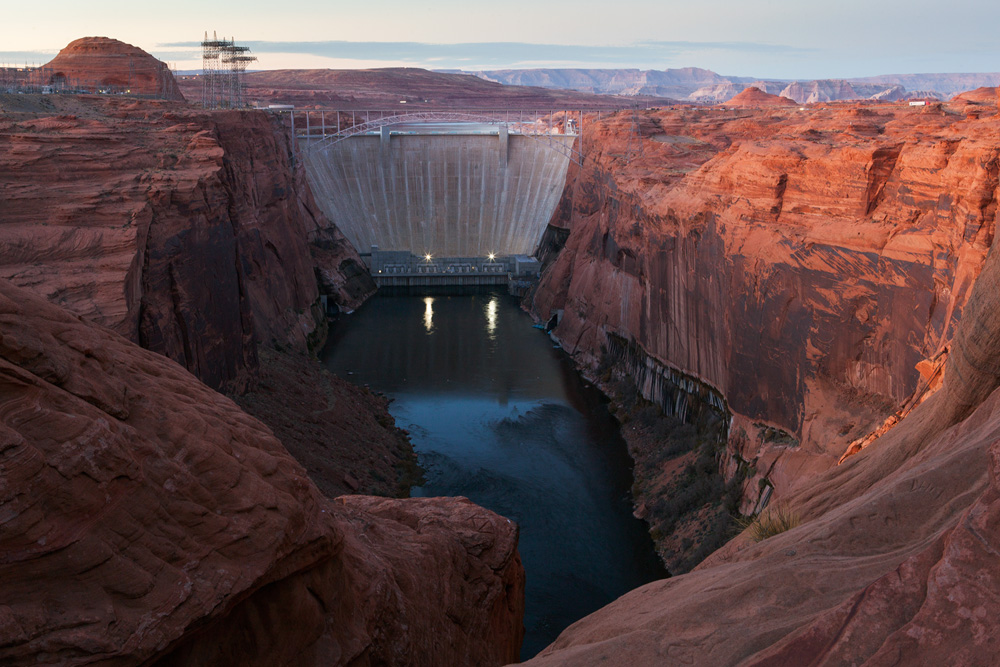
by Deep Green Resistance News Service | Sep 7, 2018 | Listening to the Land
Featured image: Glen Canyon Dam on the Colorado River. © Michelle McCarron
by Will Falk / Voices for Biodiversity
I need to come clean. When I joined Colorado River Ecosystem v. Colorado, the first-ever federal lawsuit to seek personhood and the rights of nature for a major ecosystem, my intentions were not completely sincere. The truth is, I never thought we had a chance in hell. I saw the lawsuit as an opportunity to guide concerned people through a process that would shatter their false hopes, replace them with experiential knowledge of the vast difficulties inherent in working for change within the legal system and catalyze more effective action.
The lawsuit failed, of course. The Colorado Attorney General privately threatened the attorney representing us, Jason Flores-Williams, with sanctions if he did not withdraw the case. When he refused, the Attorney General formally filed a request for sanctions with the court and a motion to dismiss in the same afternoon. Flores-Williams, afraid that he could not respond adequately to both the sanctions and the motion to dismiss, voluntarily withdrew the case.
When filing a lawsuit, however, it’s best not to proclaim publicly that you expect the case to fail. Judges jealously guard their calendars from anything they perceive to be a waste of time. Corporate and government lawyers vigilantly monitor individuals involved in cases filed against them for any opportunity to argue that novel legal theories like the rights of nature are frivolous, to label them as attempts to harass corporations or government, and to demand that they be punished with sanctions. Media pundits search for audio clips and social media posts to take out of context while accusing grassroots groups of filing lawsuits as a backhanded fundraising ploy.
At the same time, and in order to shatter as many hopes as possible, it was necessary to attract attention. No one likes a loser. If our supporters caught so much as a whiff of my true disbeliefs, when the case failed, they could mistake the failure as the result of the half-assed efforts of activists who weren’t truly committed, instead of the result of a legal system designed to protect exploitation of the natural world.
So I suspended my disbelief and dove zealously into the work. For four months, the lawsuit was my full-time job. I sifted through case law for opinions supporting our position. I wrote a portion of the document, called the “complaint,” that signaled the official filing of the lawsuit. I wrote a series of articles describing the need for the rights of nature. I gave interviews to journalists, radio hosts and members of Comedy Central’s The Opposition production team.
And I bit my tongue over and over again.
In the five weeks before the case was dismissed, I put 4,000 miles on my 2004 Jeep Grand Cherokee traveling with photographer Michelle McCarron around the Colorado River Basin. After all that stress, my poor Jeep’s transmission blew up yesterday, so I have nowhere to go and nothing to do but reflect. With time so short and the need for effective action so great, I wonder if I wasted my time appealing to a legal system that exists to protect those destroying the natural world. I wonder if I betrayed the trust of the good people rooting so hard for the lawsuit to succeed. Worst of all, I wonder if I betrayed the river.
***
I bit my tongue on the steps of the Alfred A. Arraj Federal Courthouse in Denver, for example. I stood before a crowd gathered to hear me speak about the lawsuit. We were supposed to have a hearing, but the court had postponed it at the last minute. With so many of us traveling to Denver from across the Colorado River Basin, we decided to proceed with the press conference anyway.
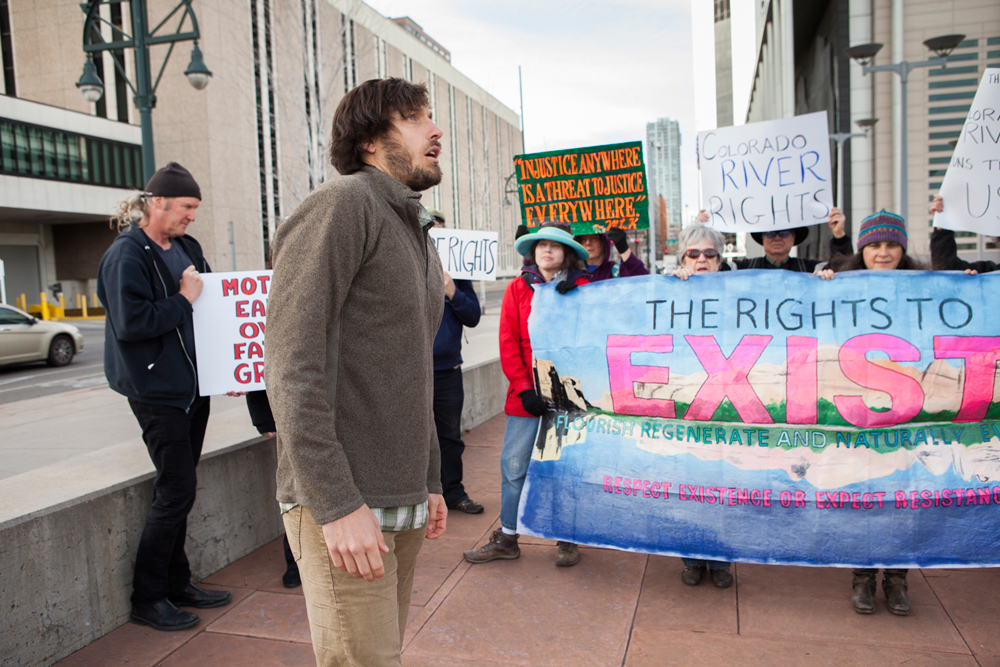
© Michelle McCarron
It wasn’t the anxiety that public speaking can induce that produced the tremor in my hand, the acid in my gut and the quiver in my voice. It was a simple question, unresolved: Is it dishonest to speak of hope when you feel none?
I began my speech explaining that I had arrived there after spending three weeks with the river. I recounted the violence I witnessed in La Poudre Pass, where the Grand Ditch lies in wait to steal the Colorado River’s water moments after the union of snowpack, sunshine and gravity gives her birth. I reported the energy expended in pumping the river’s water uphill from Lake Granby reservoir to Shadow Mountain reservoir and then into Grand Lake before the Alva B. Adams tunnel drags the water 13 miles across the Continental Divide and beneath Rocky Mountain National Park to meet Front Range demands. I described the view from Palisade, Colorado, where peaches are grown in the middle of the desert and crisscrossing canals, seen from the mountains, appear as vast, mechanical tattoos sewn into the flesh of the land.
I paused at this point, knowing that after presenting my audience with this series of distressing images, I was supposed to leave them with a positive message. While I reflected on what I had seen and said, however, I felt the river’s truth spill over me.
For weeks, I thought I had been listening to the Colorado River. But she isn’t a river anymore. Not truly. She has been so diverted and dammed, experienced so much extraction and exploitation, that the best way to describe her is not as a river, but as an industrial project, as a series of tunnels, concrete channels and canals, as another tortured corpse stretched across civilization’s rack.
While this realization washed over me, I considered our lawsuit and the rights of nature. I wondered if it is possible to grant rights to a ghost. I questioned whether the Colorado River could ever recover from what’s been done to her. Grief threatened to overwhelm me, to silence me in despair. If I had been by myself, caught in the flow of these emotions in private, or if I was simply being honest, I would have fallen to the concrete and wept. I steadied myself and as the despair trickled away, rage rushed in to take its place. That rage burned with the heat of the desert sun reflected in the Colorado’s face and I knew that, ghost or not, she who haunts is not dead.
But, again, I said nothing of her rage, of her attempts to knock down dams, of her furious floods. I said nothing to acknowledge her ghost. Instead, in calm, reasonably legal tones, I urged the crowd to support the rights of nature.
***
The case is now finished. I can stop biting my tongue and spit the blood out. I can be honest. If I betrayed you, I am sorry. If I betrayed the river, I beg forgiveness. As an act of penance, I offer the stories that follow. These stories are what I really think. These stories are what I wish I said when the journalists were scribbling down my words, when I sat, live and on air, at the radio microphones, and when the cameras were recording. These stories are the truth.
We listed the river as the only plaintiff, so it could be properly said that the Colorado River herselfwas suing the State of Colorado. Major ecosystems are not currently considered capable of bearing rights or filing their own lawsuits under American law, so I agreed, with four others, to serve as a “next friend” of the Colorado River. Similar to guardians ad litem, next friends represent the interests of those deemed legally incompetent, such as children, the mentally disabled and rivers.
Simply put, next friends speak for those who can’t speak for themselves.
On a general level, it’s not difficult to understand the Colorado River’s interests. A simple Google search will tell you that pollution kills the river’s inhabitants, climate change threatens the snowpack that provides much of the river’s water, and dams prevent the river from flowing to the sea in the Gulf of California. But, friendship, even legal “next friendship,” entails an intimate and personal relationship. To best represent the Colorado River’s interests, to be her friend, I wanted to build this intimate, personal relationship with her. To build a relationship with someone is to speak with her, to spend time with her, to listen to her. And that’s what I did.
My trip with Michelle around the Colorado River Basin was guided by two questions. Everywhere we went, I asked the Colorado River: “Who are you? And, what do you need?” I asked these questions out loud, so she could hear them. I will not apologize for talking with a river.
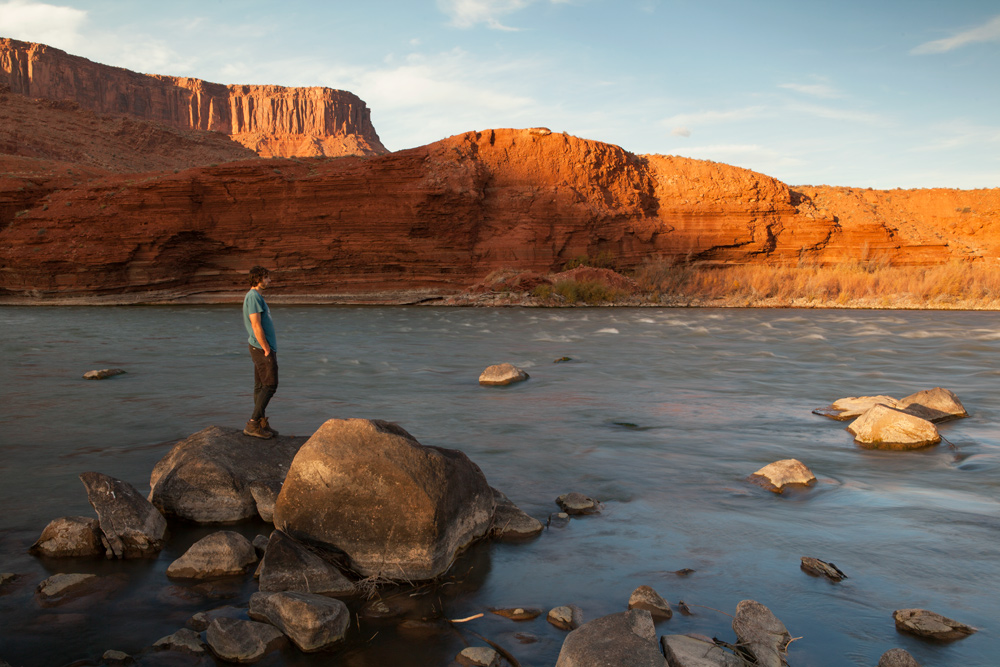
© Michelle McCarron
The Colorado River speaks, but apparently not in a language many humans understand. Water is one of life’s original vernaculars, and the Colorado River speaks an ancient dialect. Snowpack murmurs in the melting sun. Rare desert rain drops off willow branches to ring across lazy pools. Streams, running over dappled stones, sing treble while distant falls take the bass.
I am human, so I am an animal. Even though the colonization of generations of my ancestors, personal trauma and cultural conditioning threaten to deafen me, I am still capable, through my animal body, of hearing the languages of life. And I believe you are capable, too. If you’ll only try.
Though the lawsuit failed, I made a friend. When your friend is in grave danger, you do everything in your power to protect her. If you don’t, you cannot call yourself her friend. The Colorado River is in grave danger and as her friend, I know I must do everything I can to protect her. If my animality gives me the ears to listen, friendship requires that I find the tongue to translate the languages of life.
Human, animal, friend…these three existences combine and compel me to translate her voice from the languages of life into English.
***
To truly understand someone, you must begin at her birth. So, Michelle and I spent two days looking for the Colorado River’s headwaters in the cold and snow above La Poudre Pass on the north edge of Rocky Mountain National Park. The pass was accessible by an unpaved, winding, pot-holed trek named Long Draw Road. It took us fourteen miles through pine and fir forests and past the frigid Long Draw Reservoir before ending abruptly in a flat where the red trunks and brown branches of winter willows braced themselves against the breeze.
The road was covered in an inch of frosty mud that required slow speeds to avoid sliding into roadside ditches. The road’s ruggedness and incessant bumps combined with sub-freezing temperatures to ask us if we were serious about seeing the river’s headwaters. I was worried that Michelle’s ’91 Toyota Previa might struggle up the pass, but the van continued to live up to the Previa model’s cult status.
Long Draw Road foreshadowed the violence we would find at the river’s headwaters. Swathes of clearcut forests escorted us along the road to the pass. The Forest Service must have been too lazy to remove any single trees that fell on the road because their employees had simply chainsawed every tree within fifty yards of the road. About three miles from the road’s end, we ran into a long, low dam trapping mountain runoff into Long Draw Reservoir. We had been expecting to find wilderness in La Poudre Pass, so encountering the dam felt like running into a wall in the dark.
The clearcuts, dam and reservoir were grievous wounds, but none of them were as bad as the Grand Ditch. We walked a quarter-mile from the end of Long Draw Road and found a sign marking the location of the river’s headwaters. On our way to the sign, we crossed over a 30-foot deep and 30-foot wide ditch pushing water from west to east. We were on the west side of the Continental Divide, where water naturally flows west, so we contemplated what black magic engineers had employed to achieve this feat. The ditch was as conspicuous in La Poudre Pass as a scarred-over gouge on a child’s face.
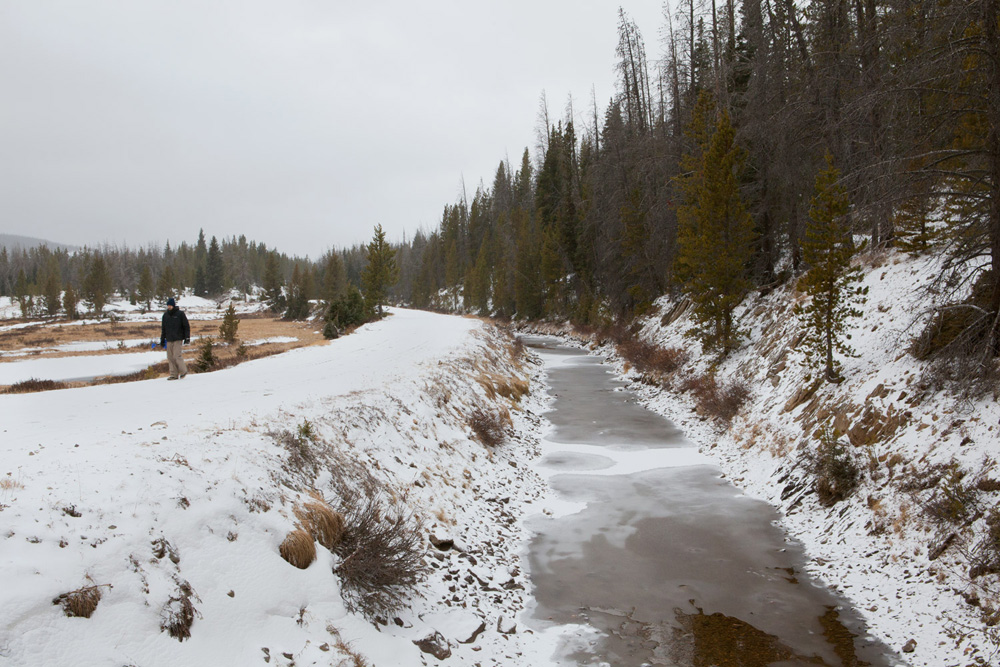
© Michelle McCarron
The Grand Ditch was begun in the late 1880s, dug by exploited crews armed with hand tools and risky dynamite. It was built to carry water, diverted from the Colorado River’s headwaters, east to growing cities on Colorado’s Front Range. About two feet of swift water ran through the ditch. Even before melting snowpack forms the tiny mountain streams identifiable as the Colorado River’s origins, water is stolen from her. Pausing in a half-foot of powder, I wondered whether the water stored here would end up on a Fort Collins golf course or stirred by the fins of a vaquita porpoise in the Gulf of California.
I asked theColorado Riverfor the tale of her nativity. She described her birth from a wild womb formed by the oceans, the sun’s consistency, heavy winter clouds, tall mountain peaks and snowpack. She rues that heremergence from this womb led immediately to her exploitation. And the young Colorado River hates the violence that will follow her the rest of her life.
***
In most places, life protects themodern human’s fragile sense of self-importance by veiling the weight of time in the soft accumulation of soil, by disguising the vastness of the universe in the reassuring consistency of an undisturbed horizon and by salving existential angst with a diversity of nonhuman companions. There are places, however, where life refuses to disguise herself and human self-importance disintegrates.
The red rock deserts and canyon lands of southeastern Utah, where we followed the Colorado River, are some of these places. The reality of time, frozen and piled where the land was rent into mesas and plateaus, crashes down on human consciousness where human bones shiver in the shadows and foreshadows are whispered by stones, boulders and the bones of the land.
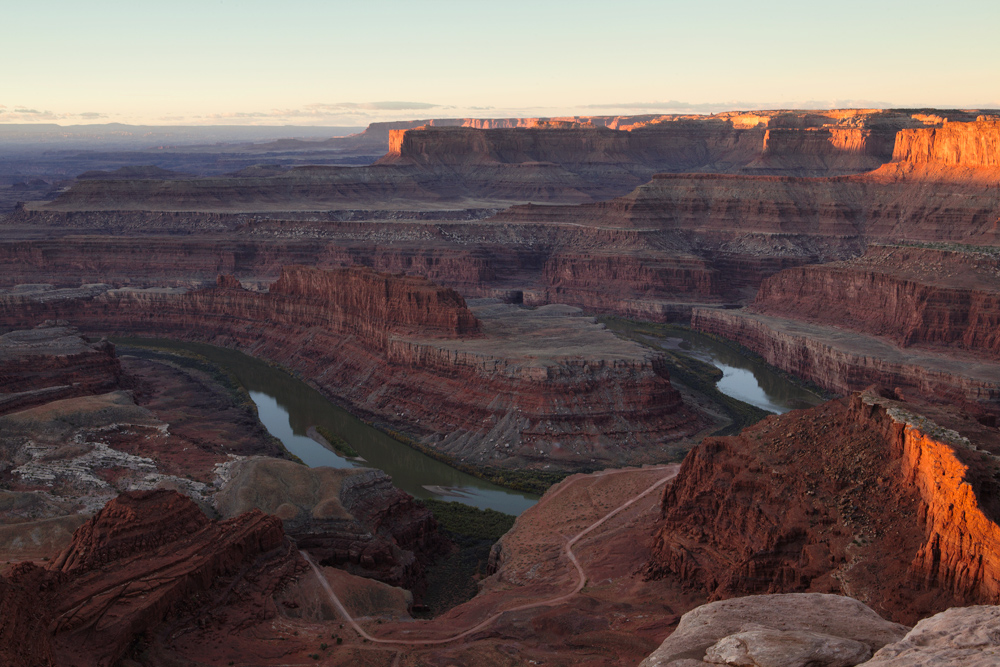
© Michelle McCarron
She beckoned us south through these lands. She fled through the sheer red rock walls that she sculpted as monuments to her power. She paused, at times, in warm pools, to let the colors of stone reflect from her face and to rejoice in her own beauty. To interpret her work as vanity is to misunderstand; only her creations are worthy of her celebration. The waters flowing through our bodies coursed against our skin and tugged on our veins, yearning to mingle with their kin. We ached with regret for the moment life would necessarily drag us from her banks.
Mesmerized and seeking the confluence of the Green and Colorado Rivers, we got lost in Canyonlands National Park. We failed to reach the confluence, and thus failed to speak with the two rivers. At first, we were angry with ourselves. We ended up hiking close to fourteen miles in seven hours, up canyon walls abruptly rising six or seven hundred feet, through a rainstorm and across canyon floors covered in several inches of loose sand using muscles we forgot we had. We thought we had done it all for nothing. Worst of all, feeling a responsibility to tell the Colorado River’s story, we thought that we had let the river down.
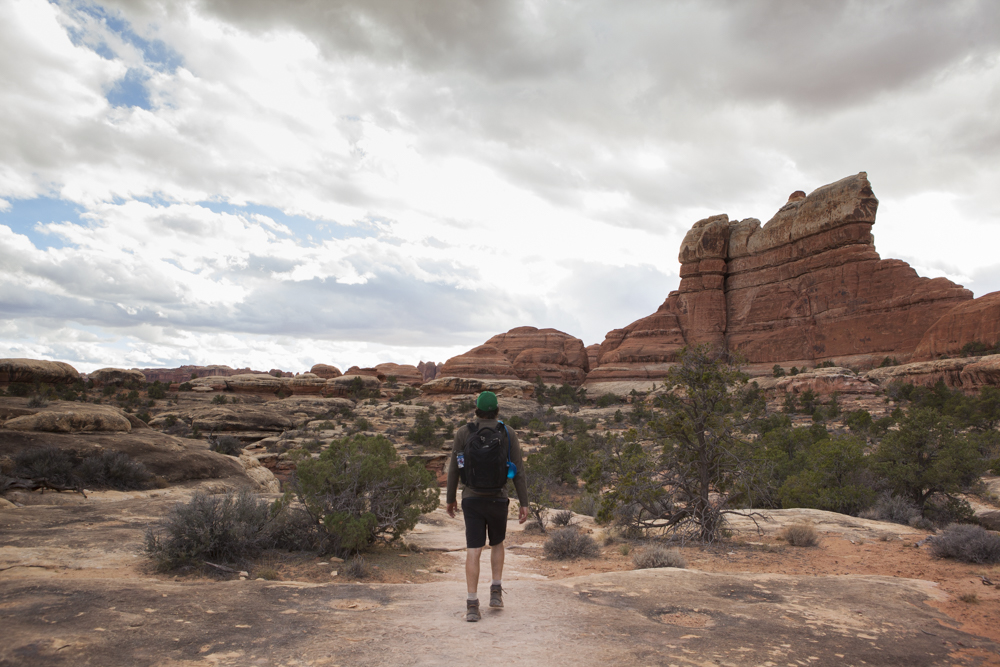
© Michelle McCarron
But the deeper I think about it, the clearer an image of the river, waving through the orange sunshine of a desert dusk, becomes. She seems to smile with the compassionate gleam of a wise elder. “You should have known,” she says. And now I do: We did not simply miss the cairns, lose the trail, and end up five miles south of the confluence and six miles from our cars after sunset. No, we lost more than the trail. We lost our self-importance. And only humility remained.
***
Water is life. But water is also death. Water brings a pleasant taste to the parched tongue, but water also brings stinging numbness to the warm-blooded. Water taken through the esophagus brings hydration. Water taken through the lungs brings suffocation. Water may be disrespected for a time, but the longer the passage of water is hampered, the angrier water becomes. Water has a long memory and, where others forget, water carries pollutants and poisons for decades.
When I think about what it would mean to fully recognize the rights of the Colorado River to exist, flourish, regenerate and naturally evolve, I know the river will demand a reckoning. I know this lyrically and I know this ecologically. Lyrically, the river is full of righteous rage. Ecologically, too many humans have come to depend on the exploitation of the river and the rest of the natural world. The balance that must be achieved will come with profound pain. Humans will die, their lifestyles will be dramatically changed and those who require the gifts of civilization will see those gifts taken.
The black waters of the dammed Blue and Colorado Rivers stroked the Dillon Reservoir walls with their dark thoughts and taught me these lessons. It was several hours after sunset and well below freezing. A certain morbidity rose from the artificial lake and crystallized to hang in the air. Somewhere out of sight, but perilously near, I could feel the stirrings of anger. I sensed that the anger was slow to swell, but irresistible when fully aroused. I was mesmerized by the stars spilling over ripples and by the crescent moon’s silver threads, two nights from new, dancing across the water. In the town of Dillon below, harsh electric lights sparked and crackled with a troubled tension.
The images came unbidden. The first faint crevice appeared in the earth-filled wall. Water hissed as it pushed through. Rivulets appeared as tears rolling down the dam’s face. Then, a series of sharp cracks rang out like the reports of heavy ordnance announcing the onset of battle. Earth and stone blasted away to fall into the valley. Water rushed into Dillon. Poles holding power lines snapped like toothpicks. Chunks of asphalt were ripped up. Automobiles flipped and tumbled like pebbles on a creek bed. Factory outlet stores, gas stations and multistory hotels were washed away.
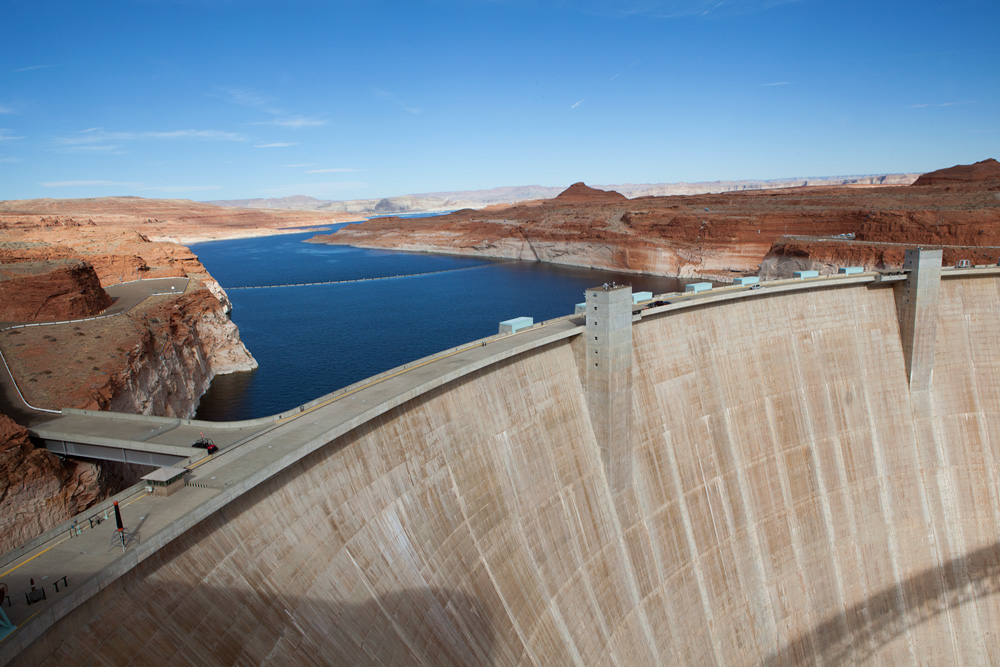
© Michelle McCarron
The white torrents that cascaded from the broken dam were flecked with joy. The waters retook the Blue River’s original path. The waters from the Colorado, knowing they would never rejoin their mother, were gladly adopted by the Blue. It was all over in a matter of minutes. This sudden demonstration of natural power passed and a quiet peace settled where Dillon once stood. The peace wasn’t without pain. Human bodies floated facedown among the wreckage. The water regretted the deaths, but knew the human bodies would be broken down and used to heal the wounds humanity had created.
As the vividness of the images faded, I was left with the echo of a warning. I recalled all the dams in the Colorado River Basin, all dams everywhere, and I prayed that a peace could be made with the dammed waters of the world.
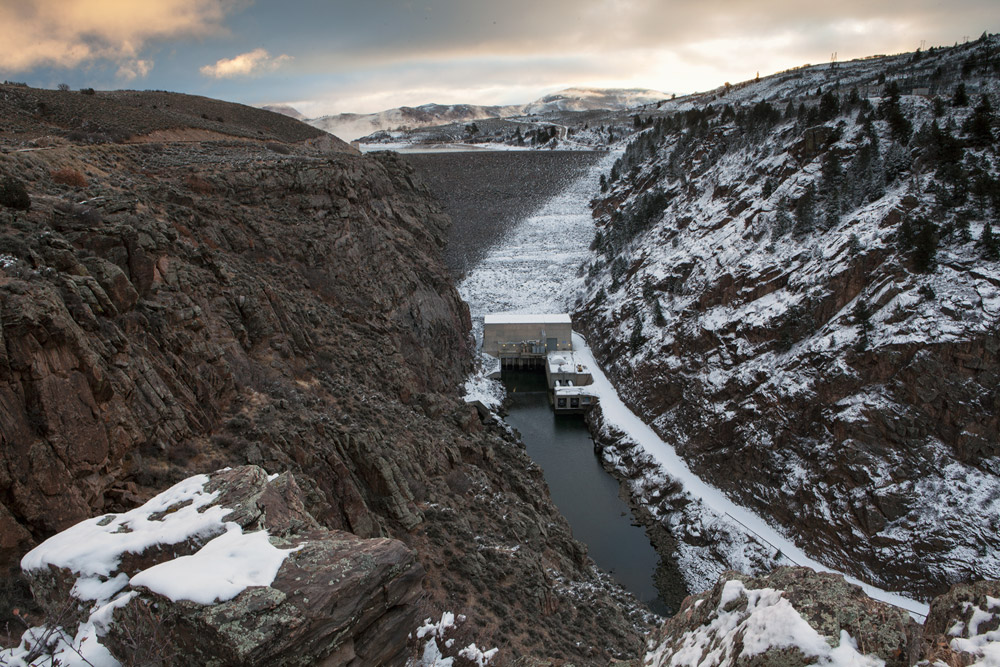
© Michelle McCarron
***
I have seen the silver sparks of minnows playing under brown stones. I have watched the wind shower gray pools with gold cottonwood leaves. I have been washed away in the vertigo caused by the river’s speed conflicting with the primordial stillness of canyon walls. Arundhati Roy wrote, “Once you see it, you can’t unsee it. And once you’ve seen it, keeping quiet, saying nothing, becomes as political an act as speaking out. There’s no innocence. Either way, you’re accountable.”
I’ll never be able to drive past a dam in the Colorado River Basin and ignore the highly endangered bonytail chub who can no longer visit most of their traditional spawning beds. I’ll never be able to read the billboards praising the peaches of Palisade, Colorado, or the melons of Green River, Utah, without remembering dried up willow forests where the songs of nimble southwestern willow flycatchers have fallen silent. And whenever I close my eyes to recall the Colorado River, that blue ribbon twisting through rocky mountains and red rock canyons, I won’t be able to unsee her suffering.
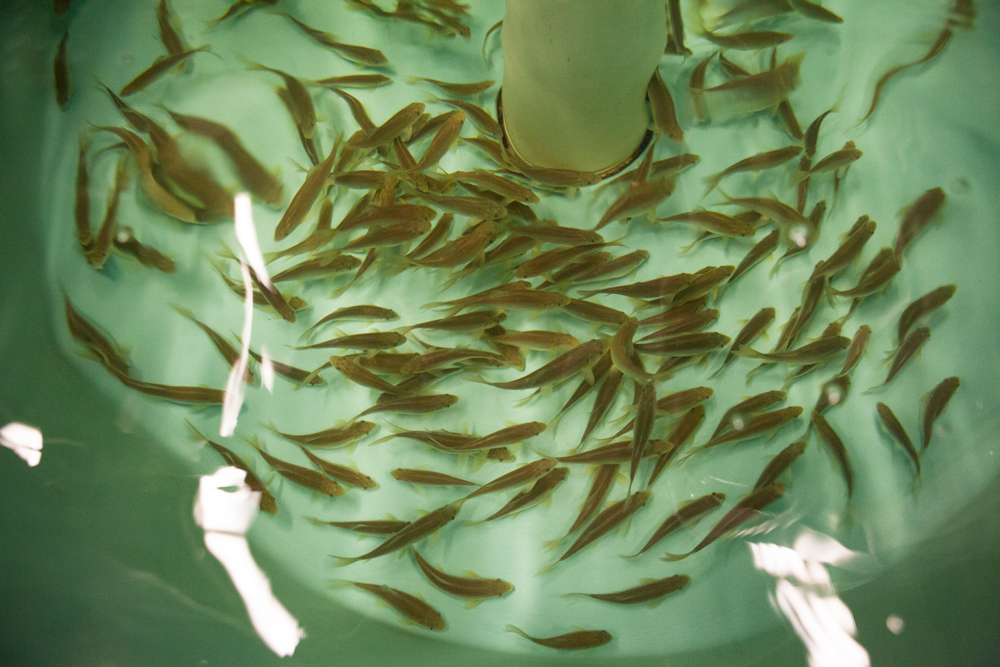
© Michelle McCarron
As I process the last four months, I’m left with Roy’s brilliant words: I am no longer innocent and it is time to be accountable. Disbeliefs may only be suspended for so long before they slither through slits in the veil separating consciousness and subconsciousness as anxieties. Anxieties, similarly, may only be silenced for so long before they push through lips and teeth as words.
Disbeliefs, anxieties and words, when true, spawn in reality. The reality is that the loss of life on Earth currently outpaces our various resistance movements’ responses. Those in power enforce infinite growth on a finite planet. The planet’s life-support systems are resilient, but they can be pushed beyond their ability to recover. This means there is a deadline. While it is unclear when that deadline will pass, the deadline exists. If we do not stop the assaults on the planet’s life-support systems like the Colorado River, life on Earth may be impossible for a very long time, if not forever. We have little time to waste on ineffective tactics.
Hear the white crash of her torrents on the boulders she drags through the desert, feel the unyielding red rock she pushes through, lose your balance in the impatience of her swift streams, and you’ll know: The Colorado River needs to provide her waters and yearns for her home in the sea.
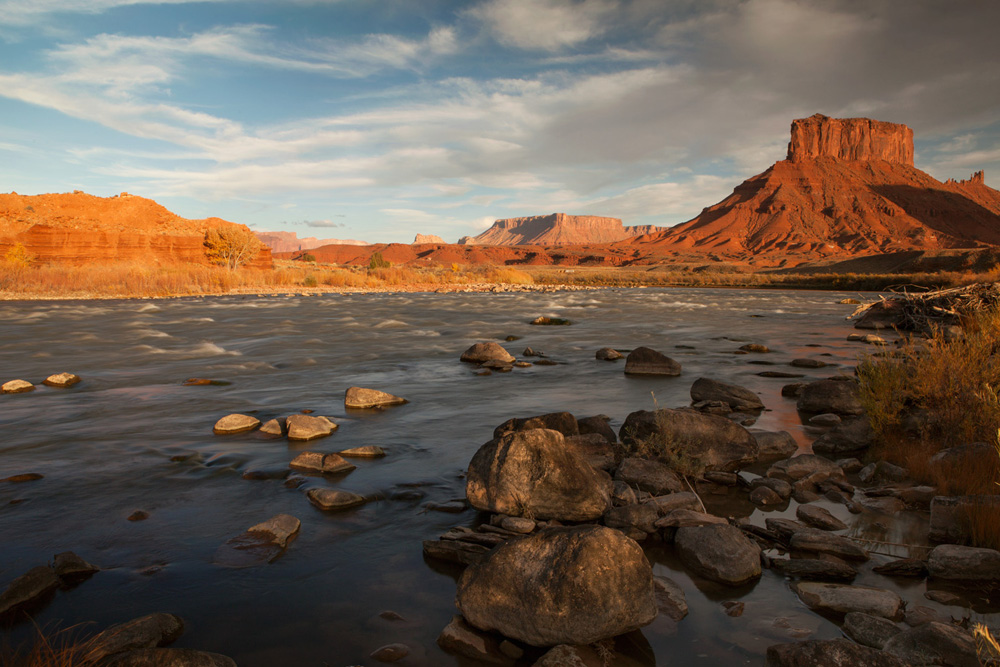
© Michelle McCarron
In all my time spent listening, I did not hear her speak of a judge’s gavel, of evidentiary proceedings or of the State of Colorado’s motion to dismiss. She cited no precedent, no binding legal authority and no argument made by silver-tongued attorneys. She did not fear questions of jurisdiction or the threat of sanctions.
No, her fears are physical and real. She fears poisonous mercury and too much selenium. She fears climate change causing less and less snow to fall and depriving her of replenishment. She fears dams.
If I could start the lawsuit all over again, maybe I would refuse the interviews, refuse to write the complaint, refuse to write anything at all. Instead, I would insist that you sit on the river’s banks, listening. And if you hear the Colorado River’s rage as she slaps the face of a dam, you’ll know that court orders aren’t the only way dams fall.
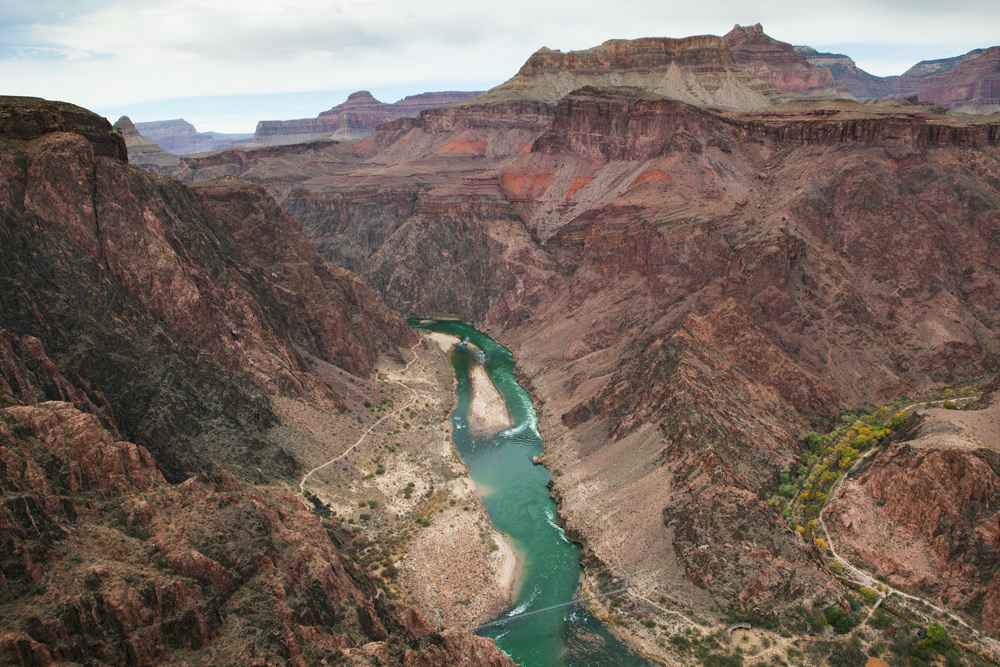
© Michelle McCarron
This article and the photos therein are the sole property of Will Falk and © Michelle McCarron and may not be reproduced or republished elsewhere without the explicit permission of the author or photographer.
This article originally appeared at Voices For Biodiversity. VFB is grateful to the Community Environmental Legal Defense Fund (CELDF) for introducing us to Will Falk and Michelle McCarron. CELDF is doing excellent work helping communities fight for nature’s rights and we are honored to collaborate with their team.


















